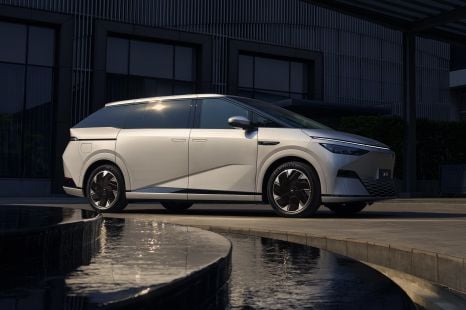

William Stopford
Will 2026 be the year of the people mover in Australia? China seems to think so
13 Hours Ago
Three-years on, UQ has expanded its electric vehicle fleet and invested in sustainable energy solutions. But what is the reality of electric vehicles for fleets, consumers and jobs Down Under?

Contributor
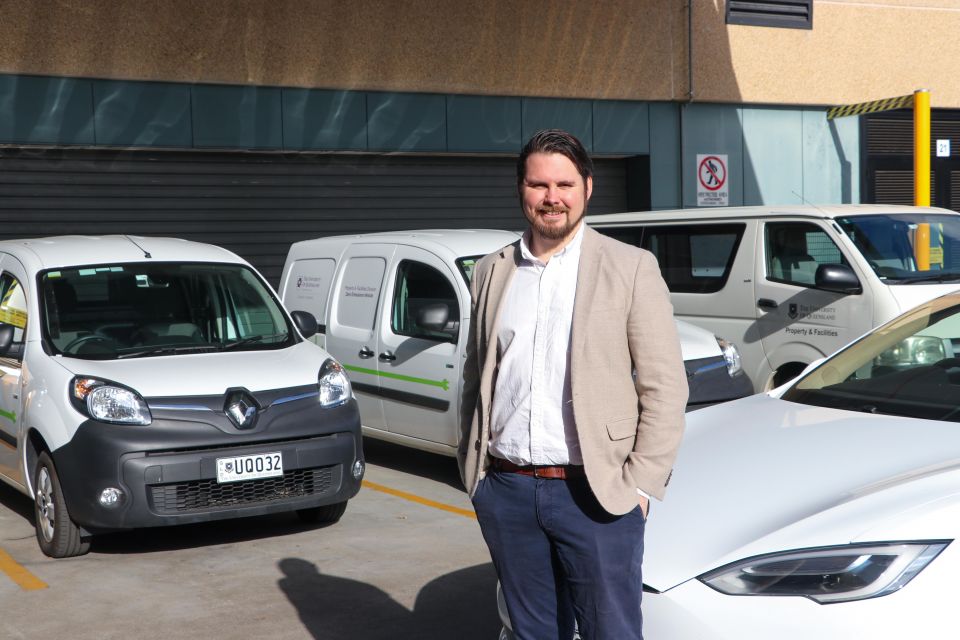

Contributor
What exactly is the ‘electric future’ in Australia?
Universities are supporting the growth of pure-electric mobility across Australia. In Queensland, tertiary institutions including Griffith University, the Queensland University of Technology (QUT) and the University of Southern Queensland (USQ) are using sustainable energy systems, accelerating electric mobility research, and employing AC and DC electric vehicle chargers on their campuses.
The University of Queensland (UQ) has made headlines for leading the nation’s research for a COVID-19 vaccine. It’s also been pushing ahead with an electric vehicle fleet and charging infrastructure investment since 2017.
We spoke to Dr Jake Whitehead, UQ’s Tritium e-Mobility Fellow to discuss the benefits of electric vehicle fleets, why he thinks hydrogen fuel-cell technology isn’t the future for cars, how Australia can play an instrumental role in EV battery pack production, and more.

Jake Whitehead: I’m Dr Jake Whitehead and I am the Tritium e-Mobility Fellow at The University of Queensland. My main role is as a researcher investigating how we can support the uptake of all forms of electro-mobility across the globe.
That’s everything from electric bikes and electric scooters, right up to electric cars, electric buses, electric trucks; and even maybe in the future, electric planes and electric boats. So, it’s a really exciting space and we’re building an interdisciplinary research team at UQ that’s focused on this entire e-mobility spectrum.
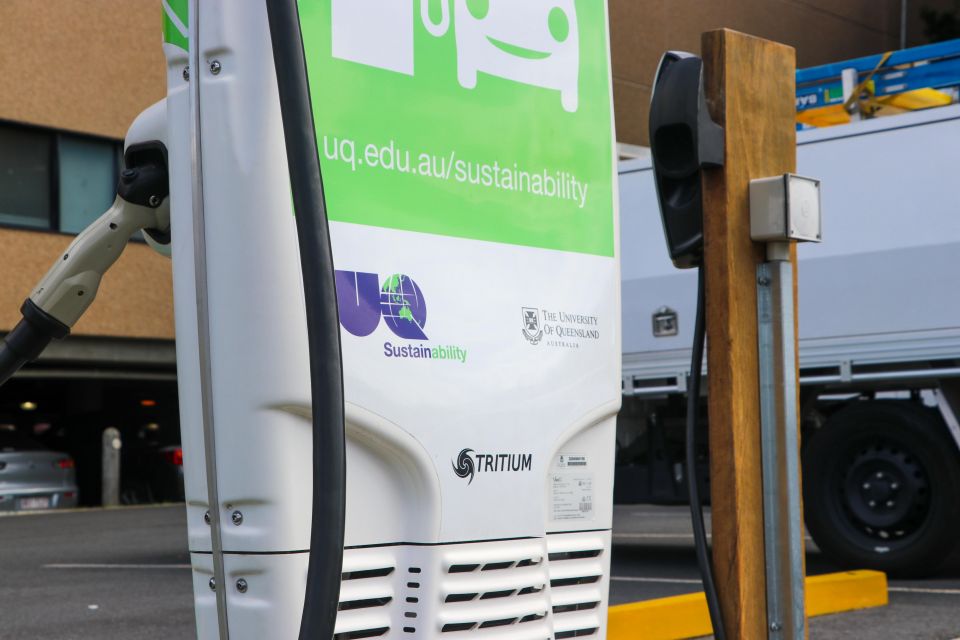
JW: The Tritium e-Mobility Fellow position at the UQ Dow Centre for Sustainable Engineering Innovation was created thanks to a philanthropic donation from Trevor and Judith St Baker, who are very generous donors to The University of Queensland. Trevor St Baker is also Chairman of Tritium.
While some of my research is affiliated with Tritium, they do not fund the position. But my position is named in recognition of Tritium’s leadership in e-mobility as a Brisbane-based advanced manufacturing company that was founded by former UQ engineering graduates.
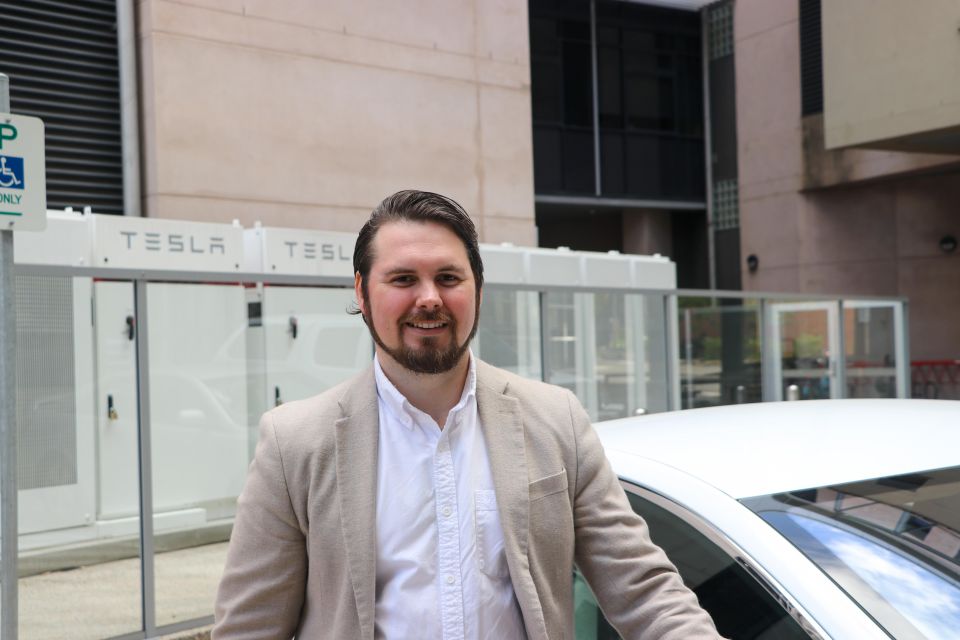
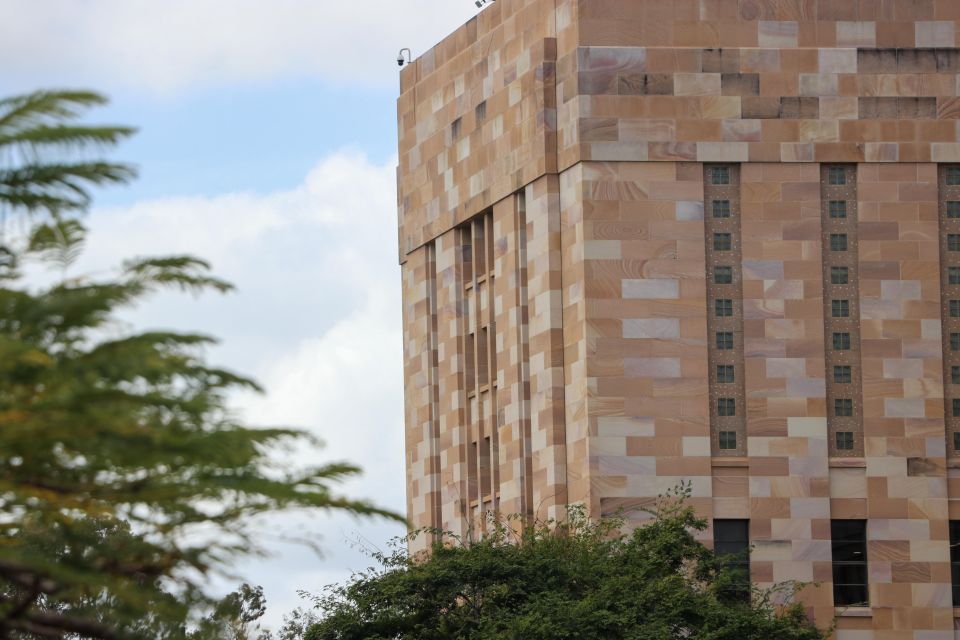
It’s a recognition of that uniqueness and the amazing home-grown success story that Tritium is.
I’m really grateful and thankful to be able to carry on that tradition of UQ leading on e-mobility and it’s a really exciting space to be to be working on right across, not just the charging infrastructure – which is obviously what Tritium’s focus is in the advanced manufacturing of fast chargers – but also understanding what general consumers want in terms of what’s most attractive to them.
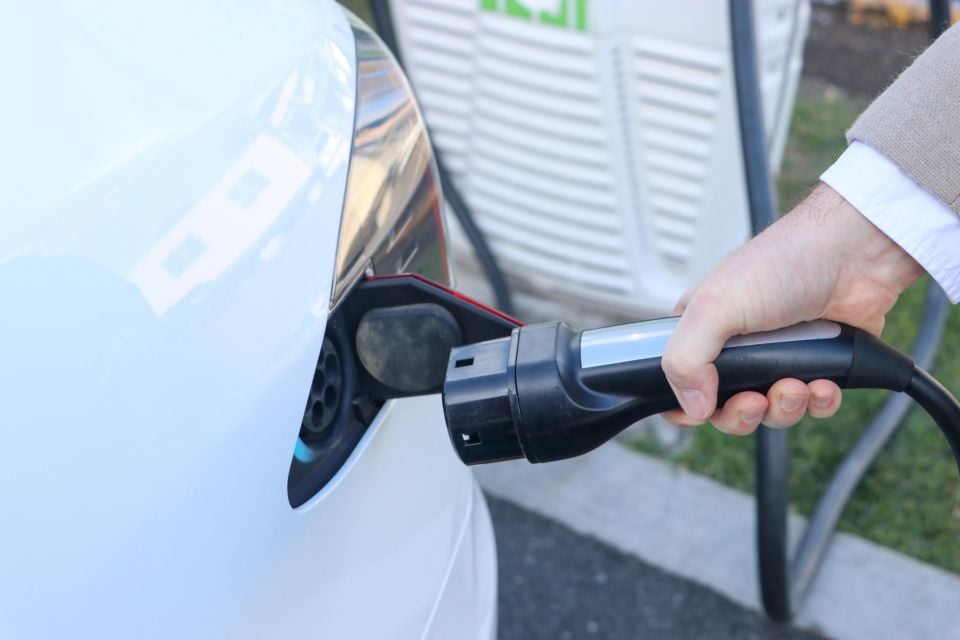
JW: I actually owned a Mitsubishi Outlander plug-in hybrid [PHEV] before the Tesla. So my wife and I got that a couple of years ago as a lease and that was our first experience in the electric vehicle world, and it was an awesome car. It could fit a lot in it. It was really convenient in terms of being able to transport different things around.
We’re avid mountain bikers and we could fit all our bikes and all our gear in there which was great. And we even got to take it on the beach to do some light four-wheel driving, so that was excellent. But then the lease came up on that and we had to decide about what we were going to do next. And actually for about 12 months, we went car-free.
For that period, we thought ‘let’s give this a go and see what it’s like to live without a car’. We live quite close to Brisbane’s CBD and realistically, it was pretty close to being able to be achieved by doing a mixture of active transport, public transport, car sharing like GoGet, and then ride sharing like your Uber, your Didi, Ola.
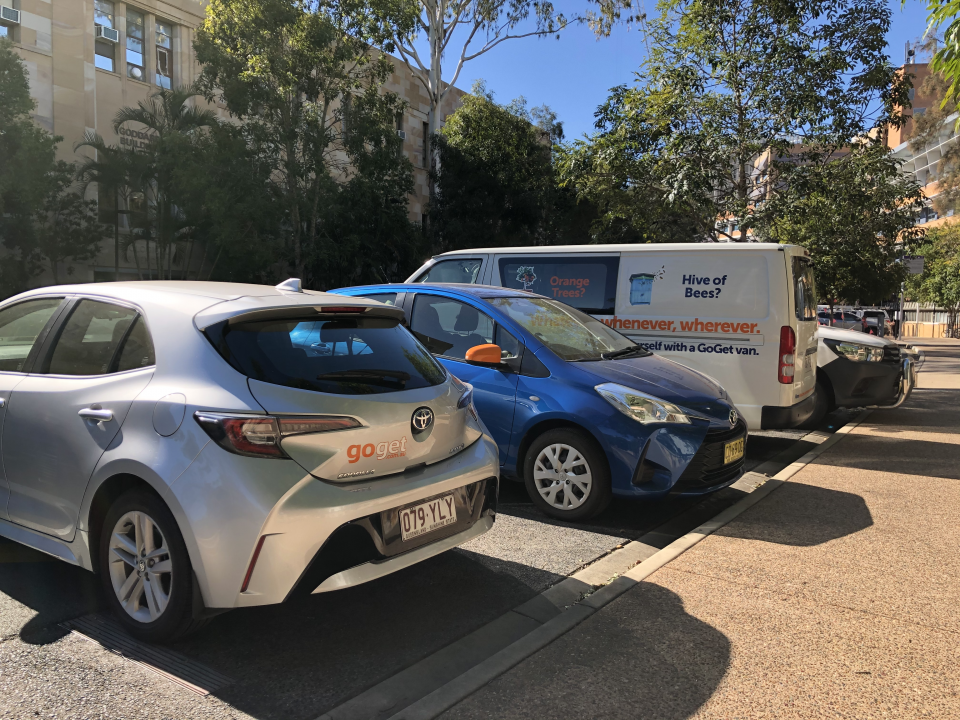
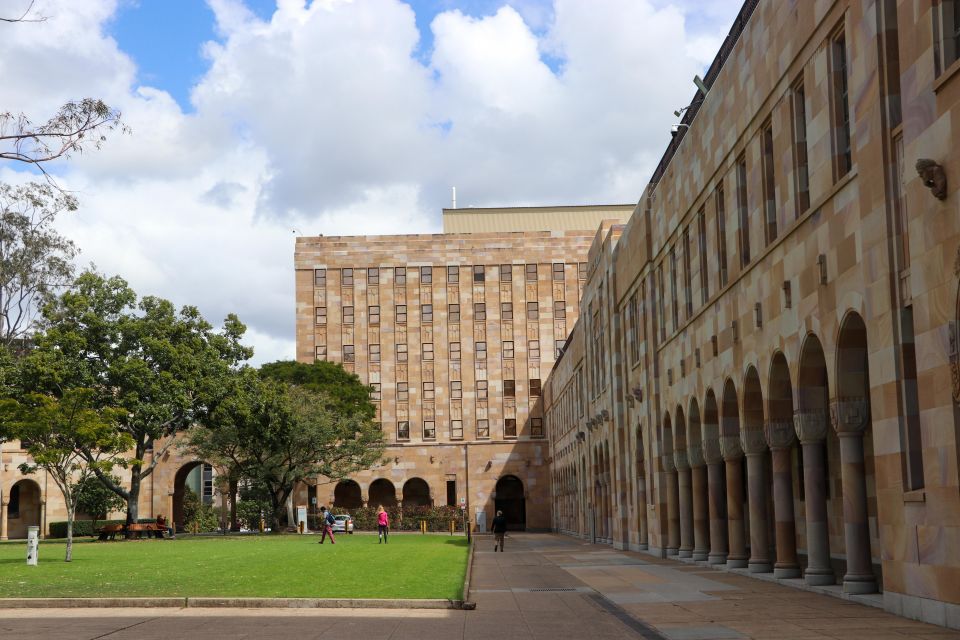
We had that experience, and then we actually went and got married overseas. We took a Tesla Model 3 for a rental during that period and we both fell in love with the car. So pretty much as soon as we got back from our honeymoon, we finalised our order on the Model 3 and got it a couple of months later.
And yes, it’s been a really great decision. It’s an awesome car. There’s lots of really good electric vehicles out there and this is just one option, but for us we very much wanted to be able to understand one of the best vehicles out there that’s electric, how it worked and what it’s capabilities are.
We both work in the transport space, so we’re also interested in autonomous vehicle features – and these aren’t yet fully autonomous vehicles – but some of the capabilities they have are pretty close.

JW: That’s right! And I must say that in lots of conversations, I’m often told by other Tesla owners that they’ve had to do some convincing with their better halves to get them across the line. But I was very fortunate in my instance that it was my wife very much pushing for us to have the vehicle. And she reminds me constantly: the car is both of ours!
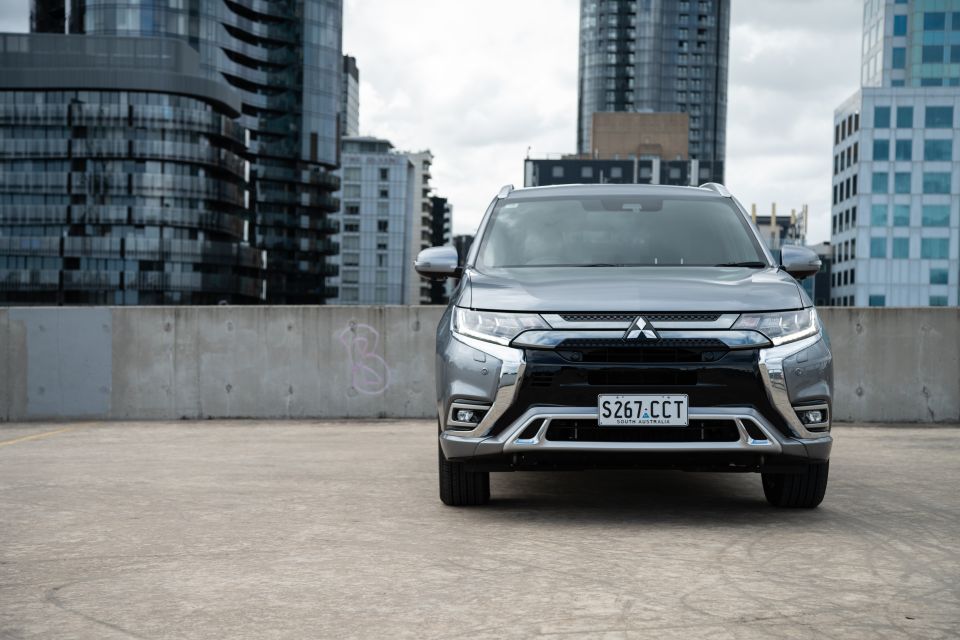
JW: I have had a couple of ICE cars. The one immediately before the Outlander [PHEV] was actually a Ford Fiesta. A number of years ago, I had set a bit of a rule for myself that I would try to only have four-cylinder vehicles that had relatively small engines to be as fuel efficient as possible.
Before the Fiesta, I had a Suzuki Jimny – which was a lot of fun, again, a very small four-cylinder petrol engine but great for going on the beach, and before that I had a Honda Prelude which was still a four-cylinder but with a little bit of a larger motor. So I’ve certainly had some experience with some different petrol cars, and they were all unique and had their pros and their cons in their own way.
But now, first going into the Outlander [PHEV] and now into the Tesla, once you’ve gone electric, it’s very difficult – I think if not impossible – to go back purely because of the performance and just also how cheap they are to run compared to a petrol car. There’s just no comparison – 90 per cent saving in fuel costs easily in an electric car.
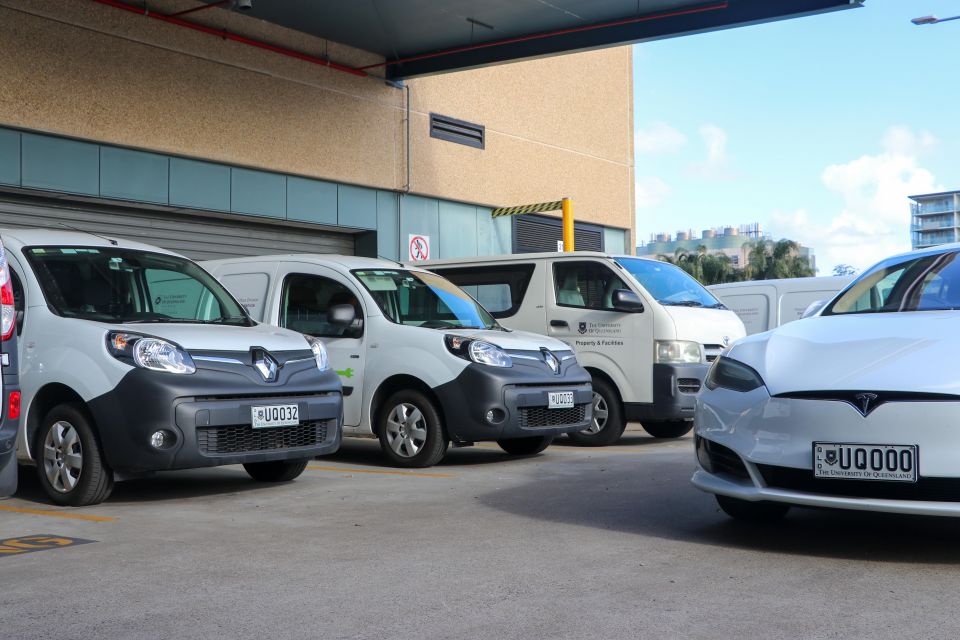
JW: I think firstly it’s important to note that UQ is really trying to be a leader in terms of the adoption of electric vehicles, and that started back in around 2017 when we got the Tesla Model S [60]. This was the base model available at that time.
The primary requirement was that we needed a vehicle that could get to our Gatton campus and back without a charge – even though we do have a charger out there just in case anything happens. Back then, the Model S was the only vehicle that was capable of reliably driving that far in different conditions. And at that time, even though it was only a couple of years ago, things have changed quite a bit.
The other big factor with the Tesla was that we wanted to give UQ staff the opportunity to experience an electric vehicle and understand what it might mean for their future.
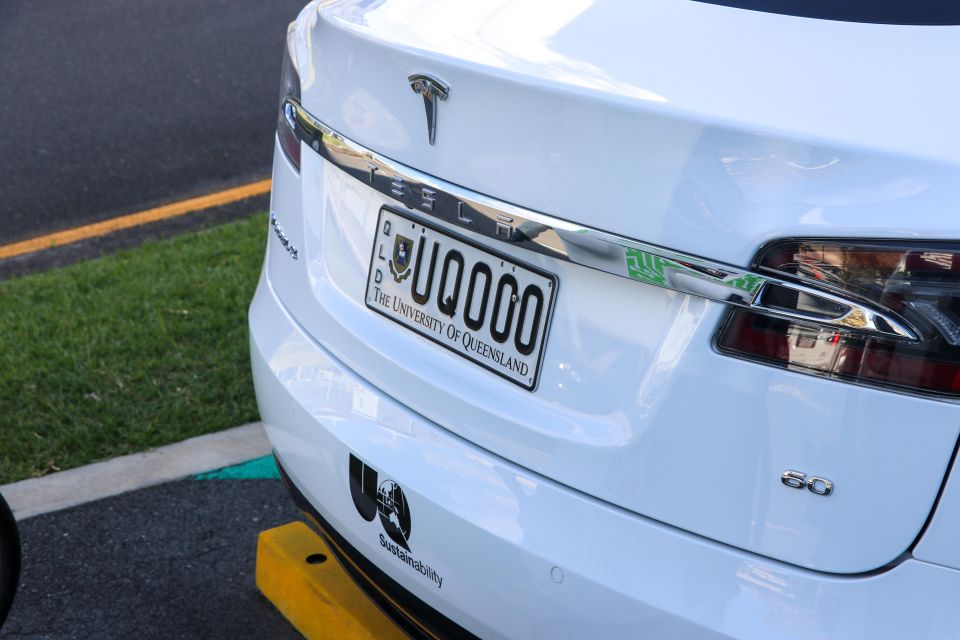
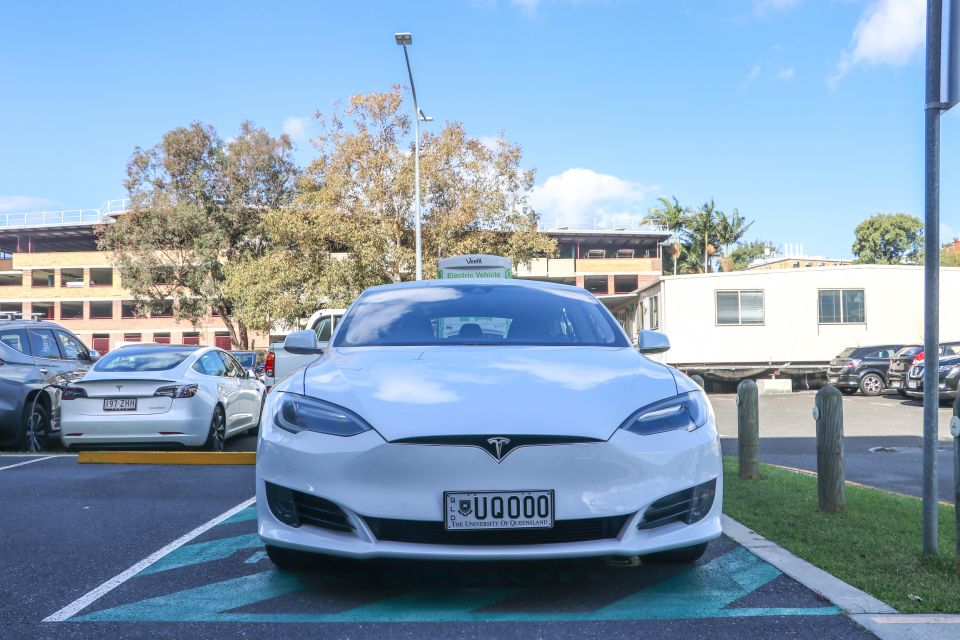
That’s been really important in trying to help shape people’s views, and getting them to understand what the technology means for them.
Moving on from that, in the past 12 months we’ve increased our electric fleet further. We’ve got a Hyundai Ioniq [Electric] and it’s actually set up as our parking enforcement car. So it’s got a roof rack with cameras that are reading the number plates and it surveils the Saint Lucia campus; automatically reading the number plates and making sure that we’ve all been paying our parking fees.
In addition to that vehicle, we have nine Renault Kangoos [Z.E.]. They’re a great commercial van that’s being used by a whole range of different facilities and teams across the university. We have quite a big campus here at Saint Lucia, as well as our campus at Gatton, and so there is a need to actually have these vehicles to get around.
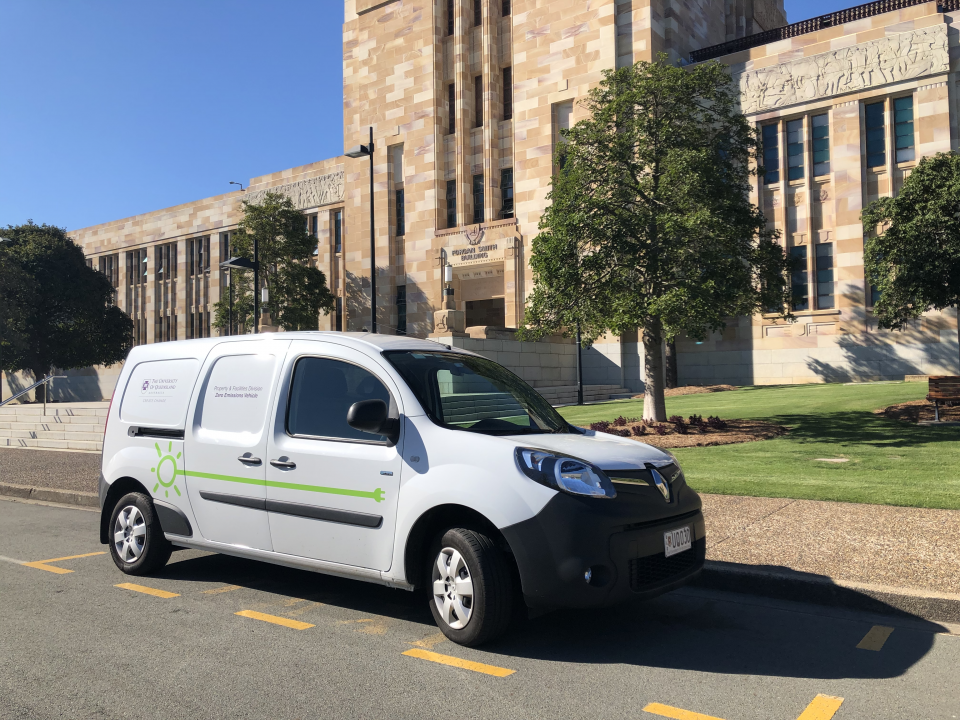
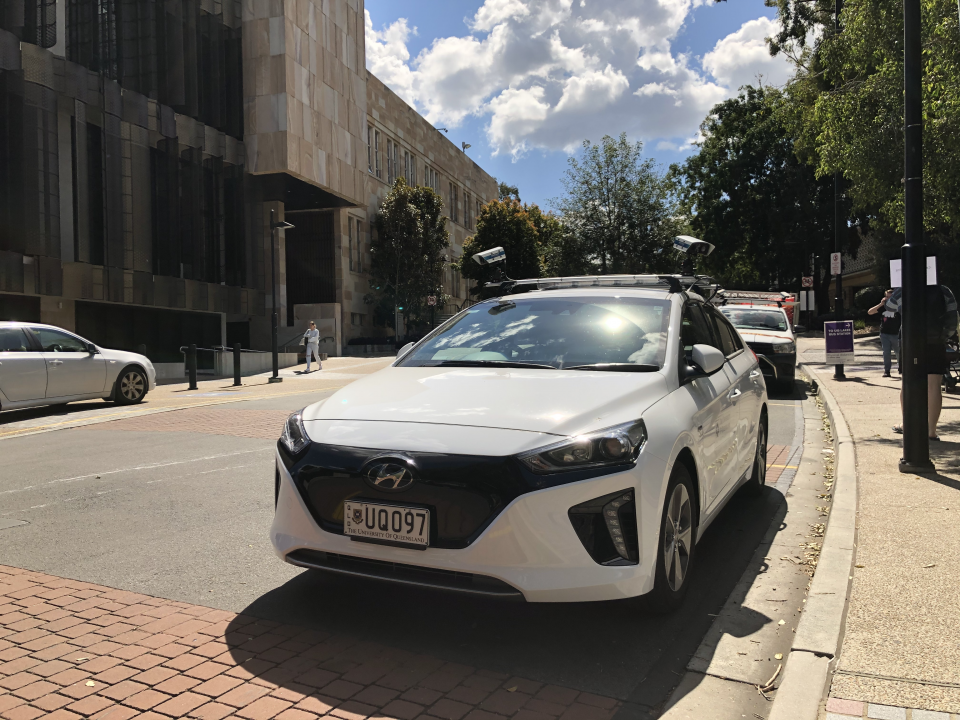
That’s where these fully electric Renault Kangoos have become a really popular hit – both with staff and I think also students seeing these vehicles going around; they’re quite proud to be at a university that’s leading in their space – and also thankful that we’re using a technology that isn’t spewing out carcinogenic fumes in the middle of this beautiful campus environment.
That’s another really important factor that I like to really hammer home, electric vehicles aren’t just about the environment. It’s just as much about trying to improve air quality for our health and in a campus environment like UQ, that’s a really big driver to move to electric.
They’re the cars. In addition to that, we also have what you could describe as electric buggies. So we’ve got 15 Cushmans and they’re again used by our property staff for doing all sorts of maintenance and different jobs around the campus.
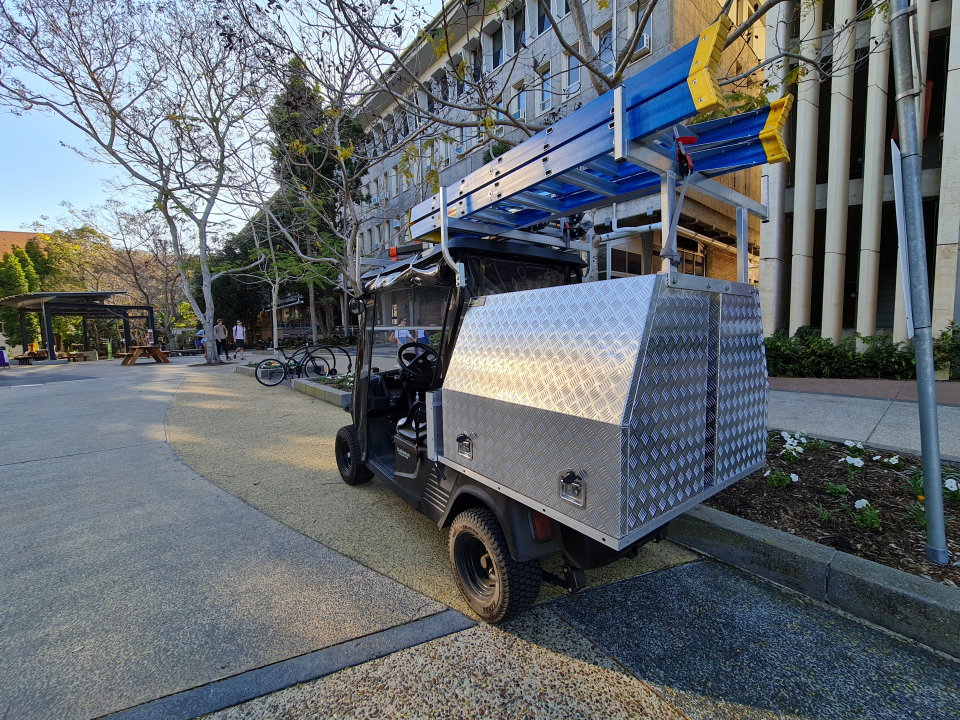
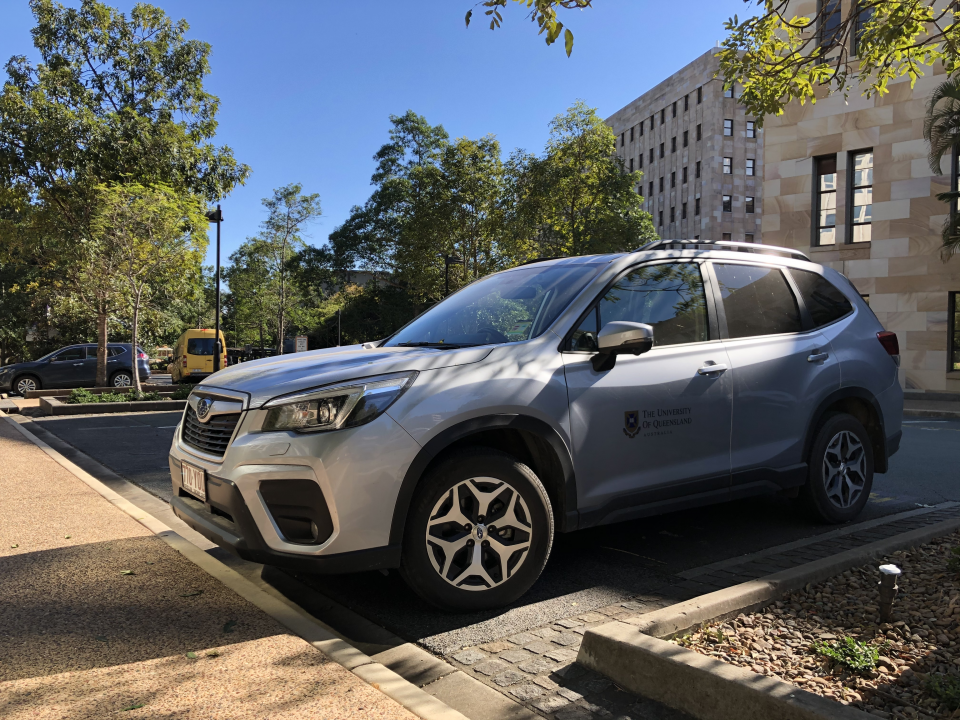
They’re quite useful because they can go off the road and fit into tinier spaces, but again, they’re 100 per cent electric and fit-for purpose for the activities on campus.
Overall, there’s about 200 vehicles in the fleet and we’re reaching about 10 per cent of that fleet being either electric or hybrid. We’re currently in the process of developing a bit of a longer-term strategy to look at how we can move closer and closer to having a 100 per cent zero-emission fleet in the future.
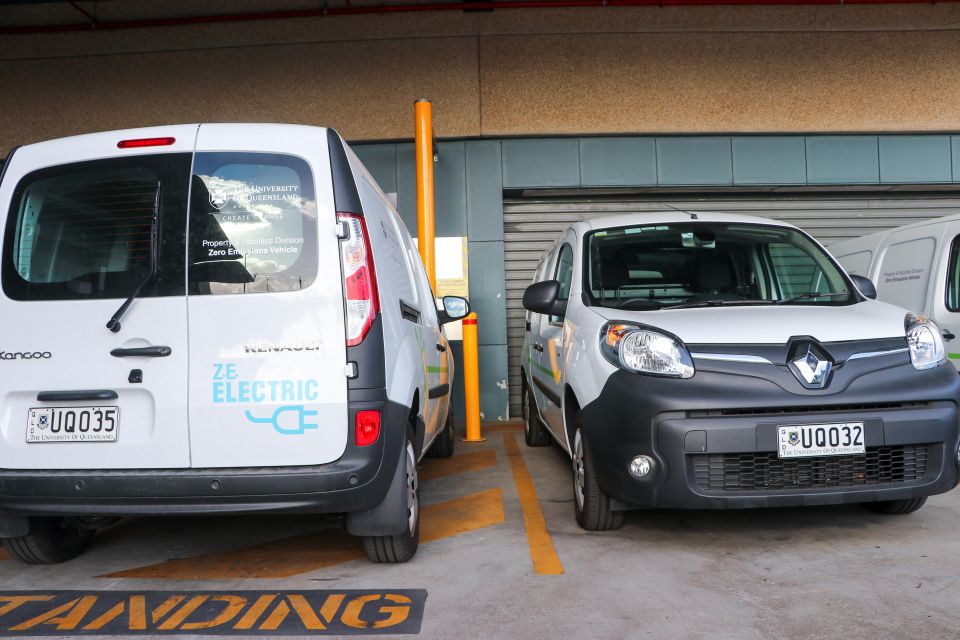
JW: When you think about costs there’s two elements: you’ve got the capital cost, which is what you pay to buy it, and then you’ve got the operating costs. Definitely in some categories across the market at the moment, electric vehicles are more expensive. But the prices have fallen quite significantly in the past couple of years.
About four years ago, the price parity was around $130,000 – and that means when you entered the market, a $130,000 electric vehicle was equivalent to a petrol or diesel model. That’s now fallen to around $70,000. Now that’s still a lot of money for the average household, but it is continuing to fall.
Several projections suggest that by about 2025, which isn’t that far away, there will be electric vehicles in the mass market around $30,000. From that point on, it will be very difficult to choose the petrol or diesel model. And that’s purely because of that second cost, which is the operating costs.
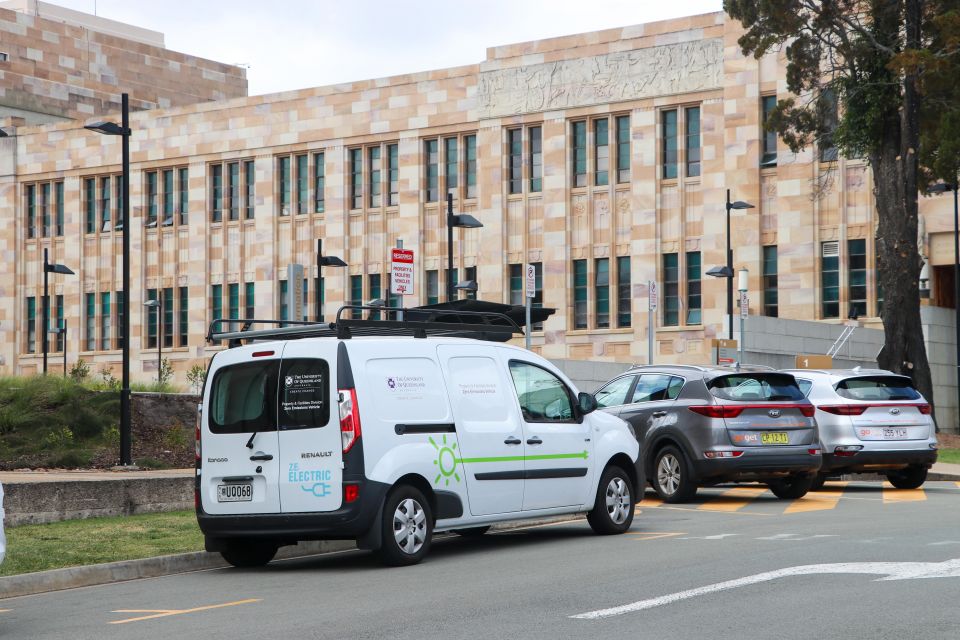

When you then think about the current situation with the [UQ] fleet – although we might be paying a bit more for the vehicle up front – in a fleet those vehicles are used so much more, they’re driven a lot further. It means that much lower operating costs can produce a massive saving.
To give people an understanding of how significant that cost difference is: if you think about petrol prices at the moment, they are anywhere from $1.30 up to a $1.60 [per litre]. When you charge an electric vehicle, you’re paying the equivalent of around $0.20 per litre – so it’s a massive 90 per cent saving, and if you add that up over time, you can definitely save a lot from that ‘whole of life cost’ perspective.
That’s where it’s important to not just think about the upfront cost, but also take into account what those ongoing costs for running the fleet are. And this is why, particularly at the moment with fleets across Australia, electric vehicles can be a viable option because when they do take into account that whole of life cost, they can be quite close to being competitive.
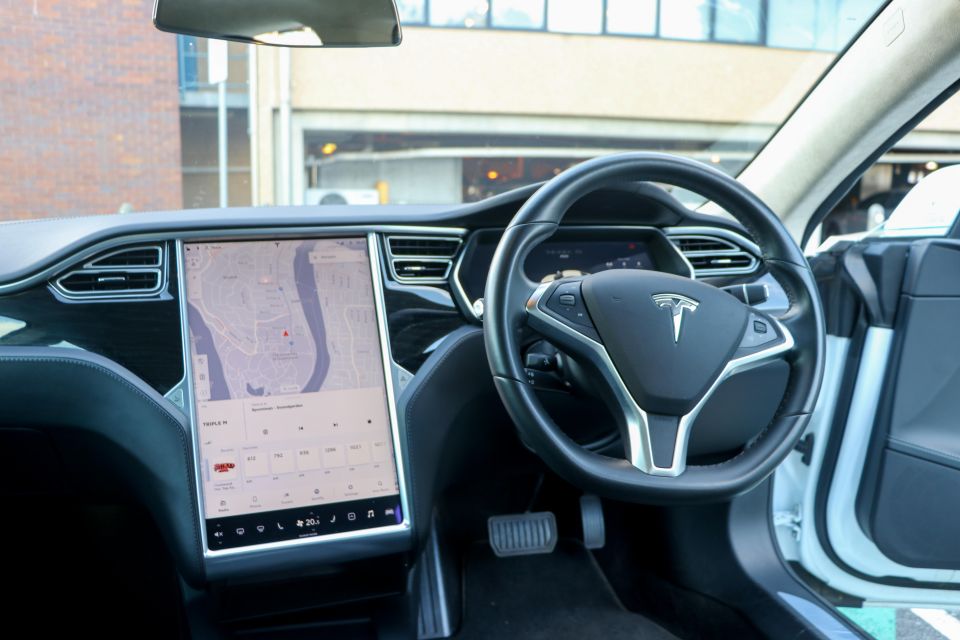
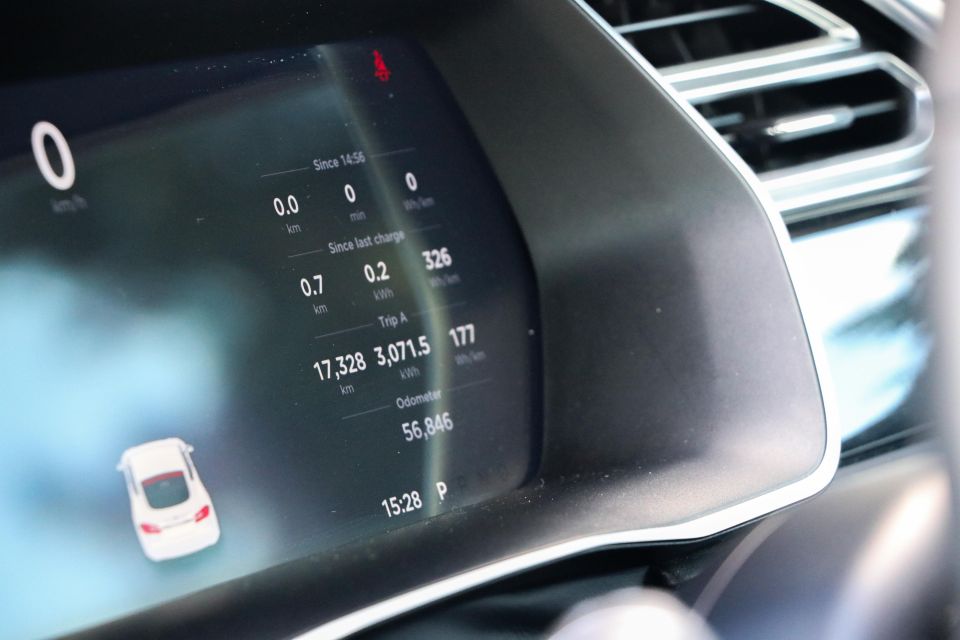
I think sometimes there are these different discussions around what governments should be doing, what fleets should be doing. But as the average consumer, we should be really supportive of fleets adopting electric vehicles – because the electric vehicles they buy today are the electric vehicles that are going to be on the second-hand market in two, three, four years time that everyone else will be able to buy.
If those electric vehicles aren’t put into fleets right now, that’s going to mean that it’s even longer before there’s a second-hand electric vehicle market for the average Australian consumer. So, we should be really supportive of these efforts, and here at UQ we’re really trying to lead by example.
Whilst we have a relatively small fleet, we want to do everything we can to try and demonstrate that this is possible, it’s economically viable, and it’s something that all fleets, all universities, all organisations in Australia should be committing to.
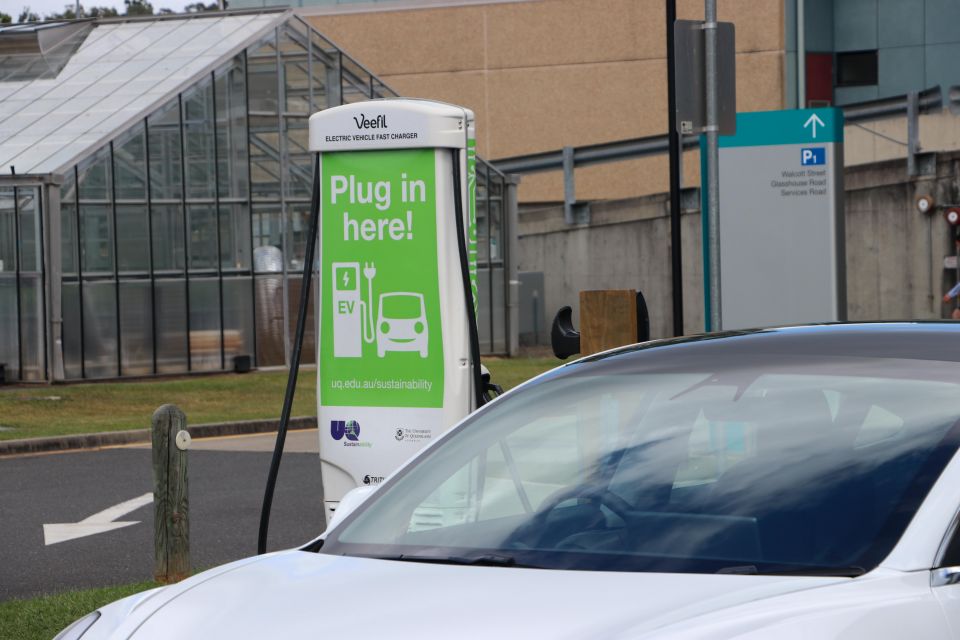
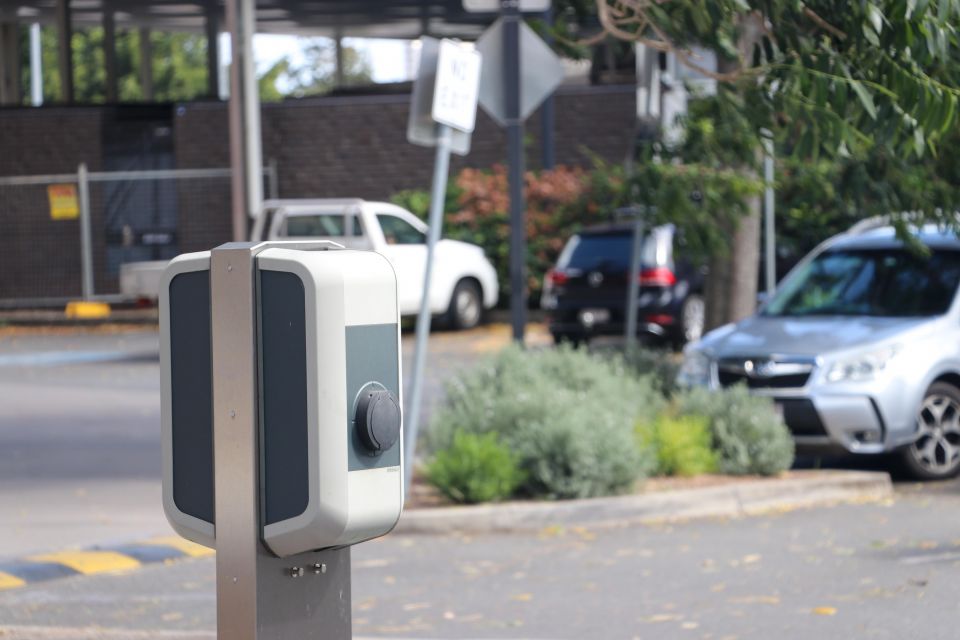
I think in terms of the motivation for the fleet, it’s not just one thing. The environmental benefits are obviously really important. We’re really proud at UQ to have launched our solar farm out at Warwick just a couple of weeks ago and very soon we’ll officially 100 per cent offset our electricity consumption across our campuses with the renewable energy we’ve produced.
Obviously having ways to use that renewable energy is really important, and electric vehicles provide a great opportunity to be able to charge from solar energy or other renewable energy sources, and have a truly zero-emission transport method.
So the first thing is sustainability. Beyond that, though, on the university campus, as I was mentioning before from a health perspective, we don’t want to be driving around petrol and diesel vehicles. Diesel is classed as a carcinogen by the World Health Organization.


We often have schools, universities, childcare centres on main roads being flooded with these fumes, and we have a responsibility to do something about that because it is having an impact on our health. In fact, there are more premature deaths in Australia from motor vehicle pollution than motor vehicle accidents.
We spend billions and billions of dollars on road safety – which is really important – but we’re doing very little in terms of vehicle emissions and that’s why we need to focus more of our efforts.
So you’ve got the environmental benefits, the health benefits, but obviously then the costs. And we can definitely see where this is heading; we’re preparing for that change and we’re very much expecting that in the next couple of years, it will be in fact cheaper to own and operate an electric vehicle compared to petrol and diesel models.
We’re not quite there yet for all use cases but we’re getting close. And as I said, in the next four to five years, that upfront cost is going to fall significantly.
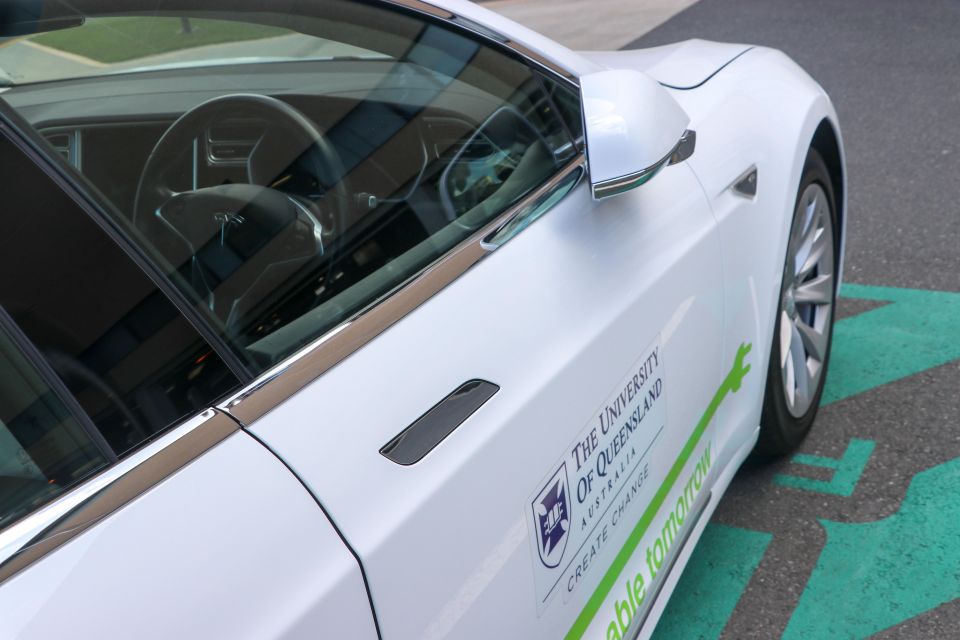
JW: I should say I’m a researcher here, so I don’t manage the fleet. In my interactions with the staff that manage the fleet here, there’s definitely some differences about electric vehicles that have been considered.
So as opposed to filling them up with petrol, you have to charge them up with electrons and so you need to have the charging infrastructure to support that. We’re quite lucky at UQ that we do have Tritium [50kW] fast chargers – one here at Saint Lucia, one at Gatton and another in Warwick – and we’ve also got a number of standard AC slower chargers that are used to charge vehicles overnight.
When you’re planning your fleet, you have to take into account that charging time. So sometimes that can take a little bit more effort compared to a petrol or diesel vehicle, but it’s not beyond being impossible – particularly when you take into account that those vehicles can quite easily charge overnight. Or if you do need a top-up, that’s where you can use the fast charger to get that vehicle back on to the road much quicker. It’s just about planning for that different mode of operation.

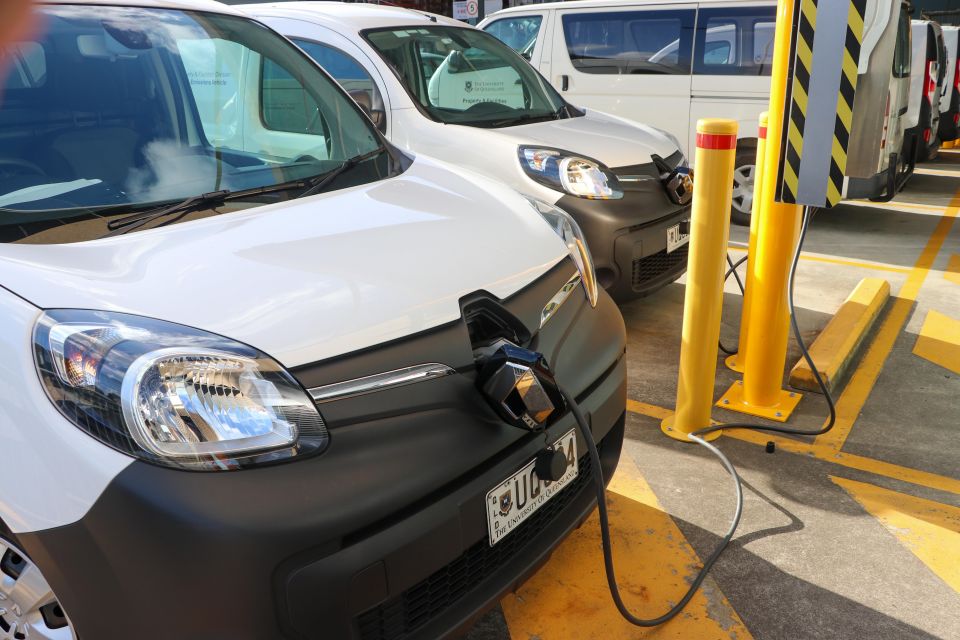
But what I’m really excited about is, in the very near future, we’re not only going to be able to use this fleet of electric vehicles for our transport purposes, but also for other energy purposes. Because when we look at electric vehicles they’re basically “batteries on wheels” and that’s where I’m doing a lot of my research – with the support of an Advance Queensland grant.
We are trying to better understand: what do these extra capabilities mean for the future if you can plug in a whole fleet of electric cars – or even just your own electric car into your house – and use that energy to maybe power your house during the peak evening period to reduce your electricity costs?
Or maybe sell electricity back to the grid when the grid needs to get more electricity because demands increase in the summer.
All of those additional economic opportunities we don’t consider now, but could actually further accelerate the uptake of electric vehicles – because you’re not only investing in a mode of transport, you’re also investing in an energy storage device which just happens to be on wheels.
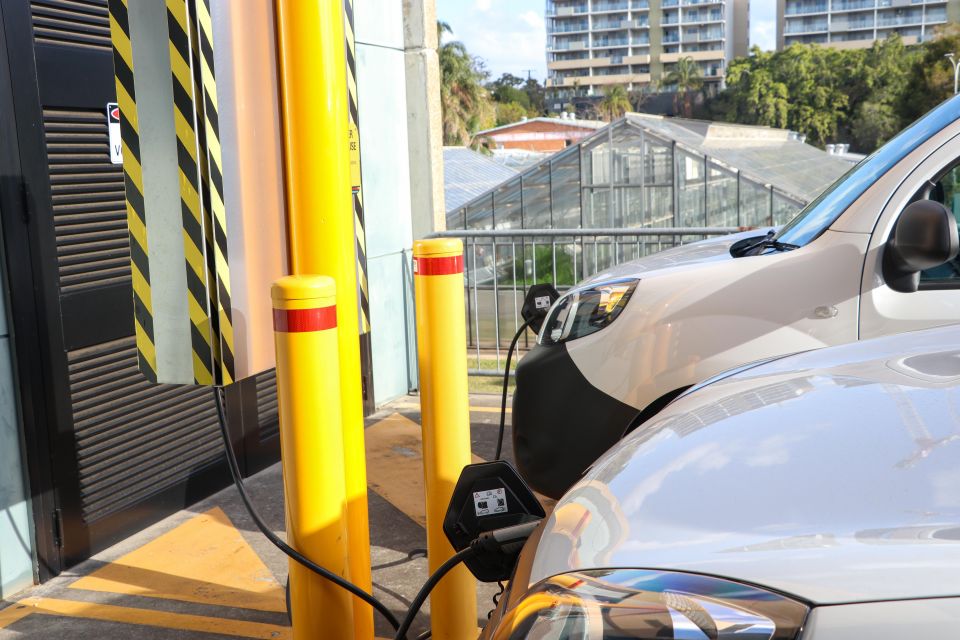
JW: I think with any new technology, there’s always challenges in getting people to adapt to something new, and it drives our motivation to get people to experience it and address maybe some of their misconceptions. But I think in terms of the UQ fleet, because there’s been a lot of planning put into the charging, it’s meant that there’s been very few instances where there’s been a major issue.
There may be the rare occasion where for some reason, one of the vehicles didn’t charge or wasn’t connected. And obviously, if you come back the next day and it hasn’t charged or it doesn’t have enough charge, that can present a problem.
But the solution to that is then, again, to have the fast-charging infrastructure where you can get a quick top-up. And certainly for fleets, it’s not necessary to have every single vehicle with a fast charger – that’s just over the top. What you would have is a number of slow chargers and maybe one or two fast chargers to help cater for those potential times where there might be an issue.

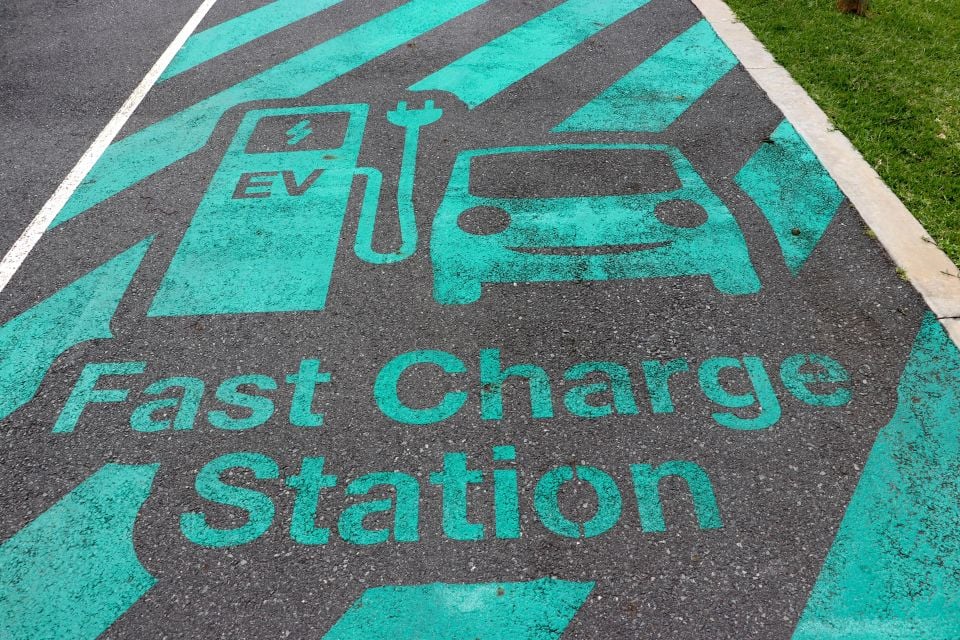
So again, it’s not to say that there’s never been an issue at all, but with a lot of planning and forward thinking about how to manage it you can minimise these risks, and that’s certainly been our experience.
I think once you start to get a larger electric fleet, there are other challenges that come about in terms of charging them and managing that charge, because you probably don’t want to have 200 vehicles charging all at the same time, in the one location.
You’ve got to have a smart strategy about managing those loads so it spreads it out over time and potentially over multiple locations. But that’s something that we’re actively looking at: how to implement what we call ‘smart charging’ and be able to charge at periods where you have excess renewable energy and not charge in periods where it’s either very high demand on the grid or a cloud comes over and the renewable energy generation drops.
It’s certainly different to petrol and diesel and that’s why it’s important to have that planning approach. But also I think from UQ’s perspective, we hope that we can form a case study for other fleets to be able to understand how you implement this technology, how you use it and be able to follow in our footsteps.
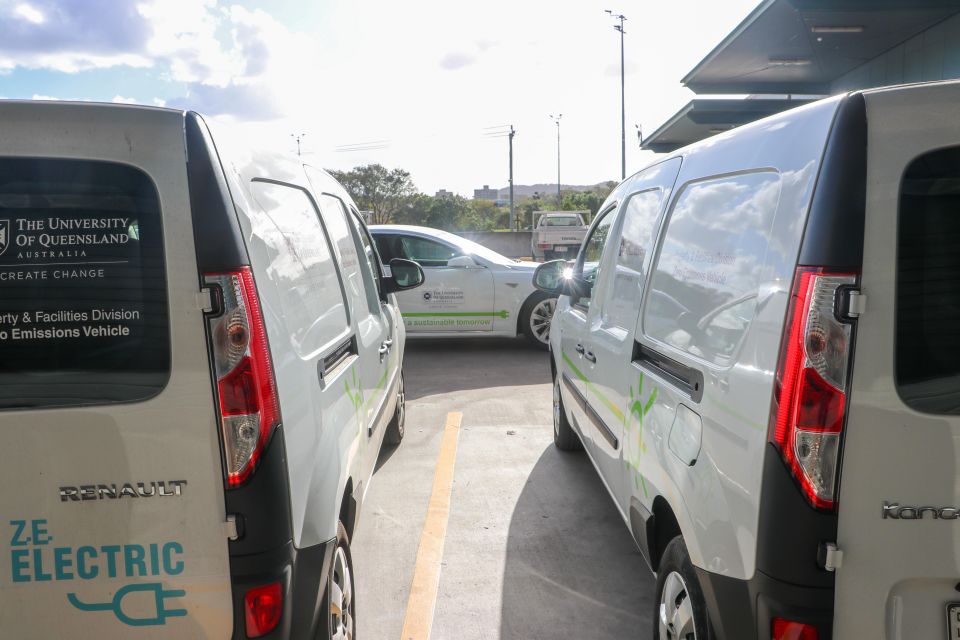
JW: Firstly in terms of the driving range – although 200 kilometres might not seem like a long distance if you are going away on a holiday – actually for general delivery vehicles, even delivery trucks, they are driven around 150 kilometres in total per day. So for that type of vehicle, a driving range of 150 to 200 kilometres is actually more than sufficient to be able to cater for average requirements.
Now obviously for the general consumer, they might want to drive a longer distance; they’re going to want to have a longer driving range. From the work we do with consumers, generally the magic number is about 300 kilometres, so people are very willing to have an electric vehicle if it’s got a minimum of 300km.
Anything below that; they’re less keen. That’s the first point in terms of driving range.
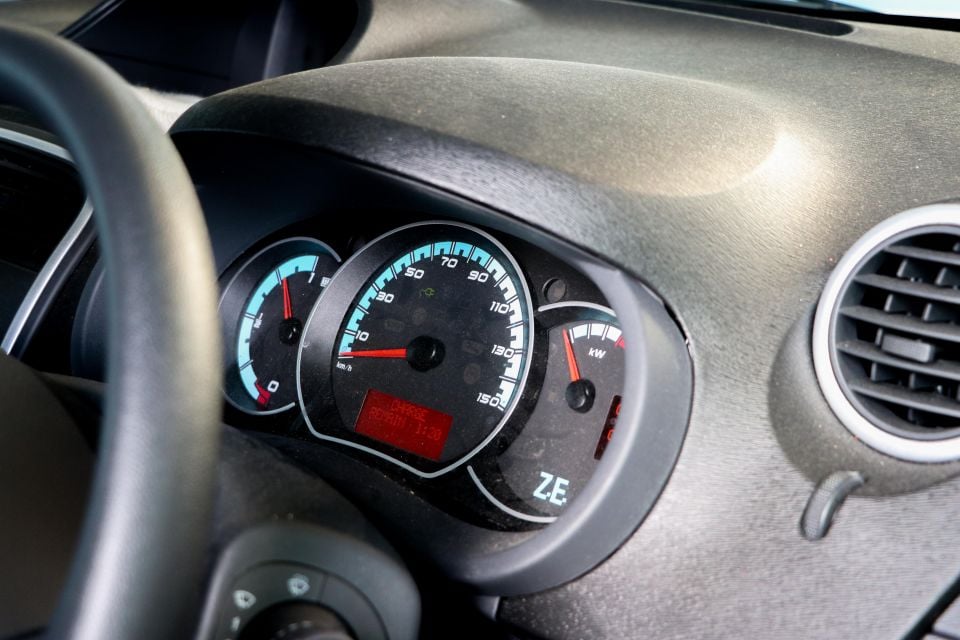
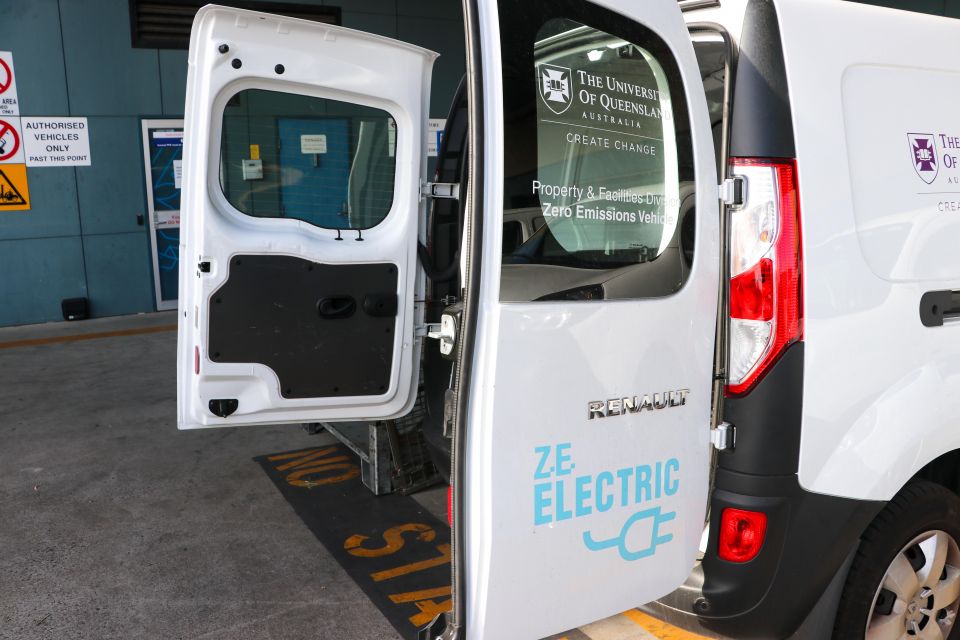
In terms of ensuring that you do have that charge every day, from a fleet manager’s perspective, instead of the fleet manager having to ensure that they fill up the car with petrol or diesel, they’re checking on what the state of charge [SoC] is and ensuring the vehicles are plugged in to charge overnight, or while parked and unused.
We had a look at a couple of electric Kangoos today and you saw that not all of them were actually plugged in; only two or three of them. That was because those were the ones that had the lowest charge, they’re going to get topped up over the weekend.
The others are still fine to be used on Monday because they still have more than enough charge to fulfil the average daily use.
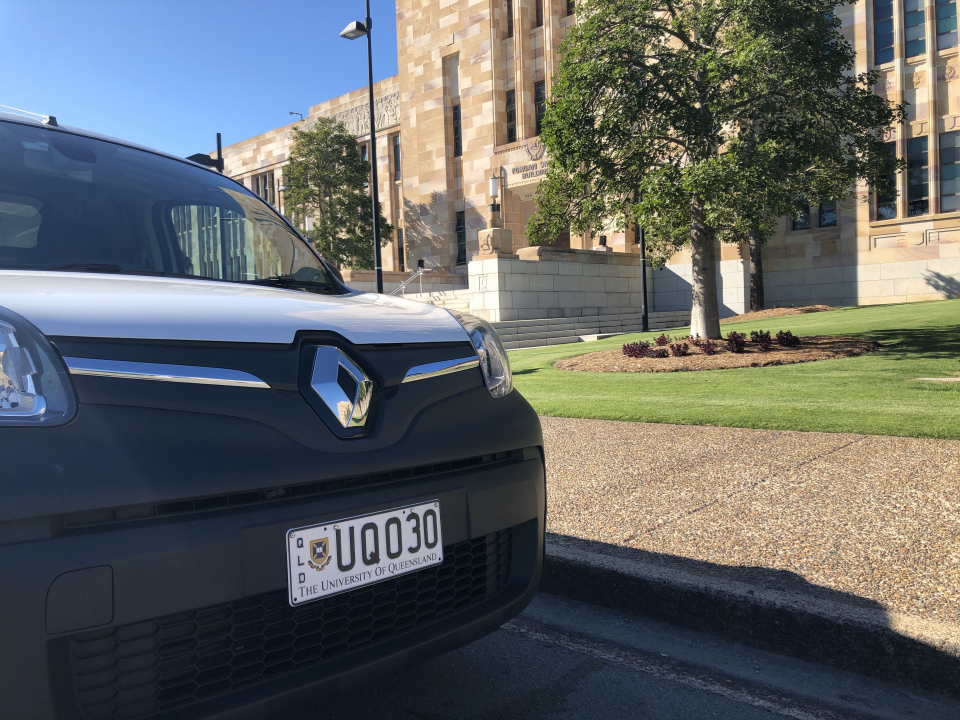
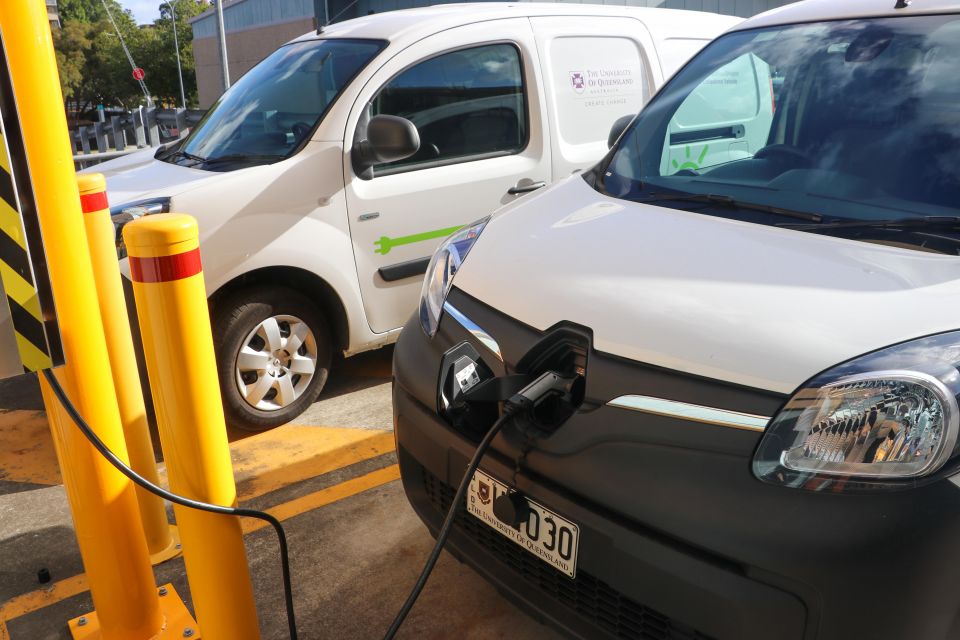
Now if you need to fully cycle that vehicle every day, you might either need to have more chargers or you might need to have a strategy where those chargers are swapped part way through the charging period, so it does depend very much on how the vehicles are used. That’s why there’s not a one size fits all solution.
We do a lot of work talking with fleets internationally to understand their needs. It’s very clear that every fleet operates differently, have different requirements, different needs and so you really need to cater and design both the fleet and the charging strategy to suit each individual fleet.
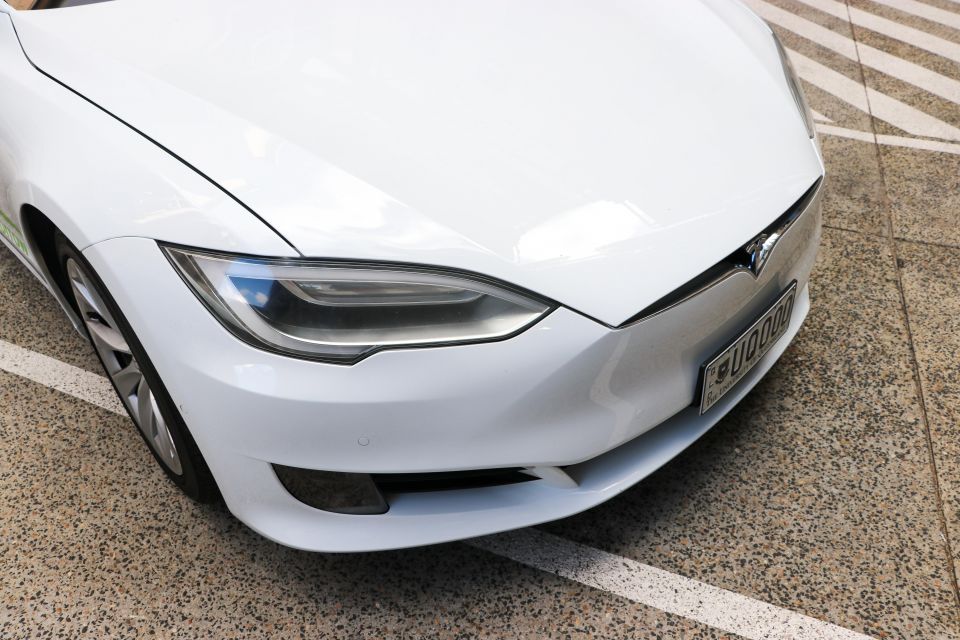
JW: The first point: a phone and electric vehicle are very different. They’re not the same at all. It’s a very common question asked. But in fact when you think about a phone, it’s a very compact battery that has to be crammed into this small space because we don’t want to carry around a brick.
But what that means is, the phone battery is not very well supported, particularly in terms of temperature. And one of the key things with lithium-ion batteries is they’re very sensitive to temperature.
Lithium batteries want to be kept at an ideal temperature – somewhere between 15 and 35 degrees [celsius]. That’s where with an electric vehicle, it’s really important to have active thermal management so if it’s too cold, the battery can be heated up and if it’s too warm, the battery can be cooled down.

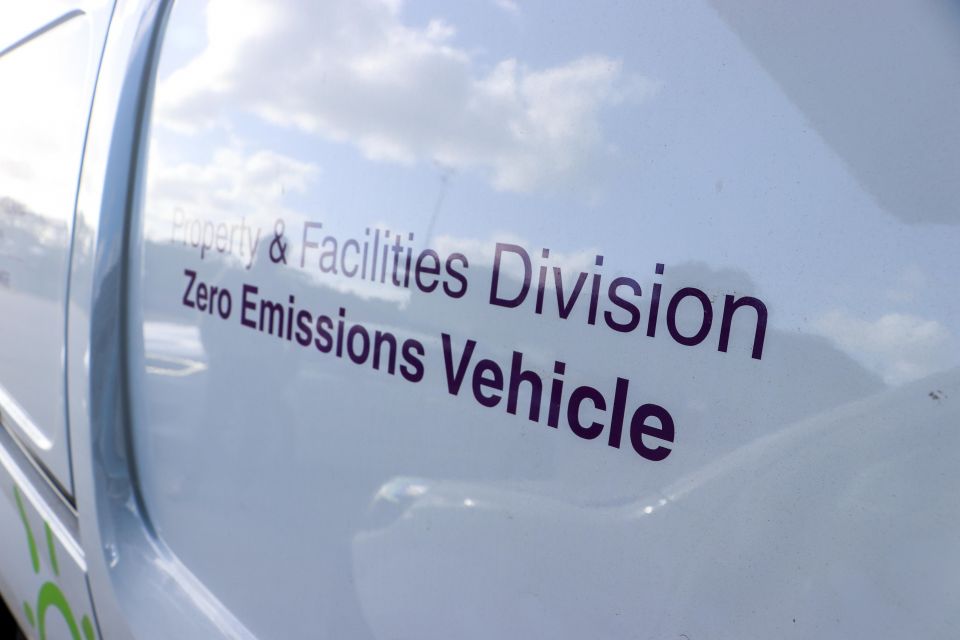
From a number of years now, we’ve seen clear evidence that for those electric vehicles that have active thermal management, they have a much longer battery life and less degradation. We expect that electric vehicles sold today with active thermal management will have around 15 years usable life in a car – very similar to the average life of a petrol or diesel vehicle
And even after that 15 years, the battery still works; it will just have dropped by around 30 per cent in capacity. You could take that battery out of an electric vehicle and run a couple of houses with it for another 10-15 years. That second-life application is really important, and an exciting future opportunity.
Now, if you leave the vehicle unplugged, the battery capacity will reduce a little bit – but you’re talking about a number of months for that vehicle to completely drain.
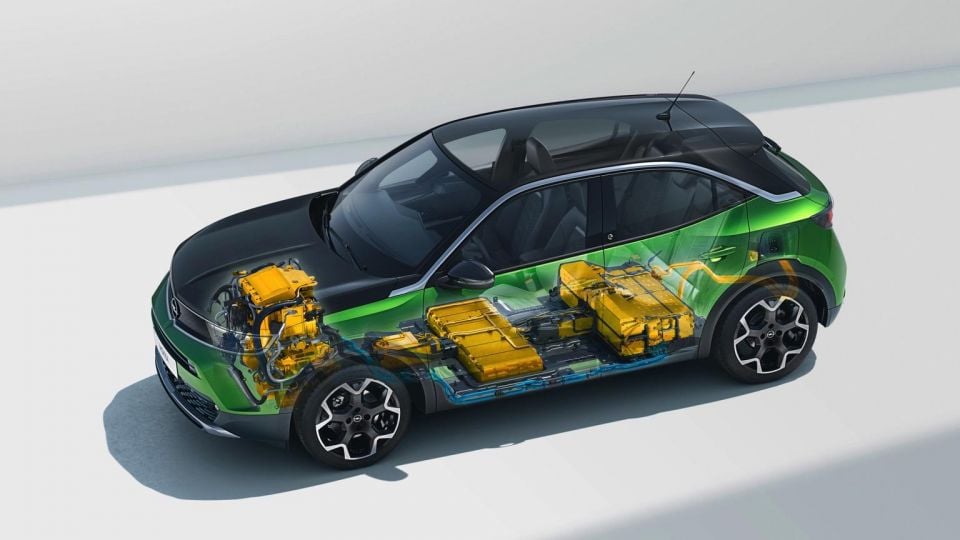
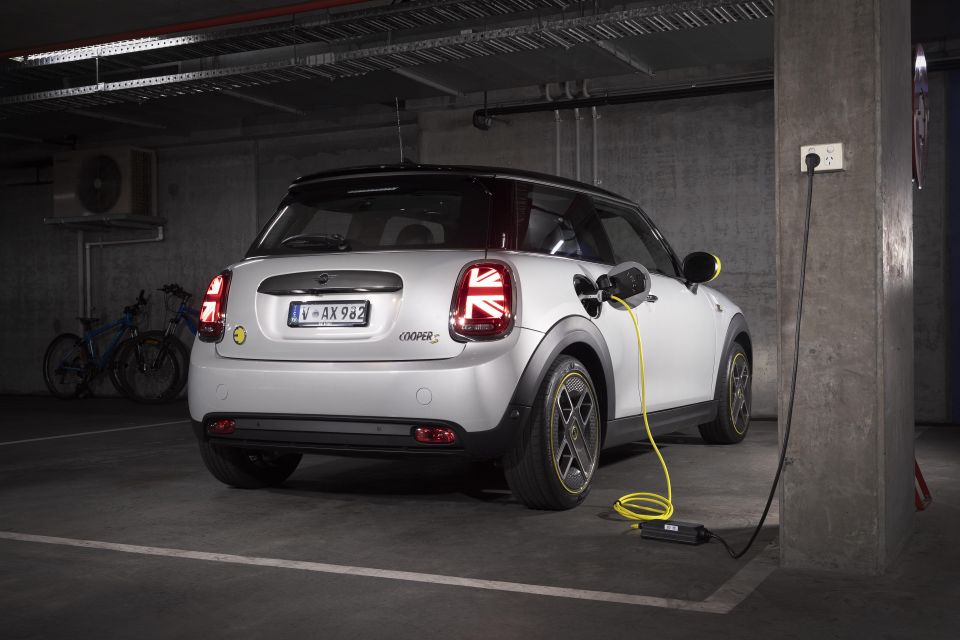
So it’s highly unlikely that situation would occur, and the vehicle manufacturers recommend that if you’re leaving that vehicle for an extended period of time, you should always leave it plugged in and the vehicle will then self-regulate and be able to manage the battery’s state of charge.
Coming to this specific example of UQ. Whilst we did have a shutdown due to COVID-19, a number of our facilities were still operating and the campus still needed to be maintained. Whilst the vehicles were being used less, they were still in operation. So yes, in a global pandemic it’s a disruption to business as usual and you have to think things through. But the great thing with electric vehicles is that they’re pretty intelligent and if you keep them plugged in, they will self-regulate.
And if you don’t plug them in, they will give you warnings as well. So a number of them now have smartphone applications built-in and if that battery charge reduces past a set level, you’ll get a notification. You really have to be trying your hardest to end up with an electric vehicle being completely empty.

JW: To begin with, there are no hydrogen refuelling stations available. So if you don’t have an energy source, you can’t possibly adopt the technology. Secondly, hydrogen vehicles are incredibly expensive – far more expensive than an electric vehicle and their operating costs are much higher, too.
So it’s very difficult to then justify why you would invest in a technology that costs more to purchase – and also costs more than twice the price of petrol to fill up. It’s very difficult to justify it from that perspective.
It’s a little bit of a misnomer in the industry that we always get quoted these refuelling times for hydrogen vehicles and we’re told, yes, it’s equivalent to a petrol vehicle. What often isn’t told is that only applies to the first or second vehicle that fills up.
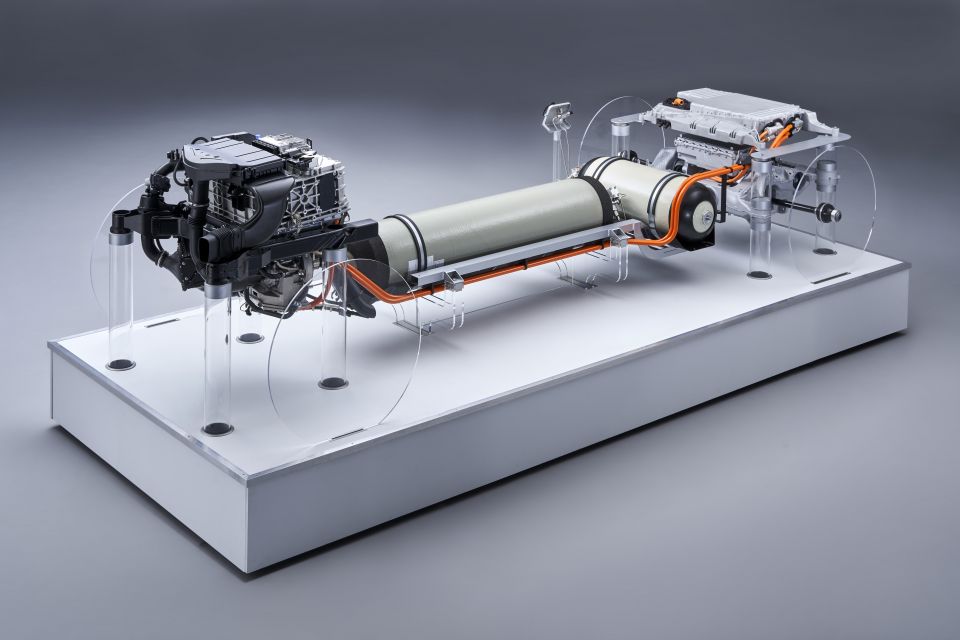

When that second or third vehicle comes along to the hydrogen fuelling station, it’s probably going to wait up to 10 to 20 minutes for the system to re-pressurise before it can fill up again. Certainly, when you start to get higher numbers of these vehicles, you may have a slightly shorter time compared to electric vehicles – but it’s not equivalent to petrol and diesel and so it still requires planning.
Additionally, in terms of that market, when we look across the entire world there are fewer hydrogen fuel-cell vehicles globally than electric vehicles in Australia.
We don’t have a huge number of electric vehicles in Australia – currently around 20,000 – but if you can imagine across the entire world, there’s fewer hydrogen vehicles. This is compared to over 7 million electric vehicles globally.
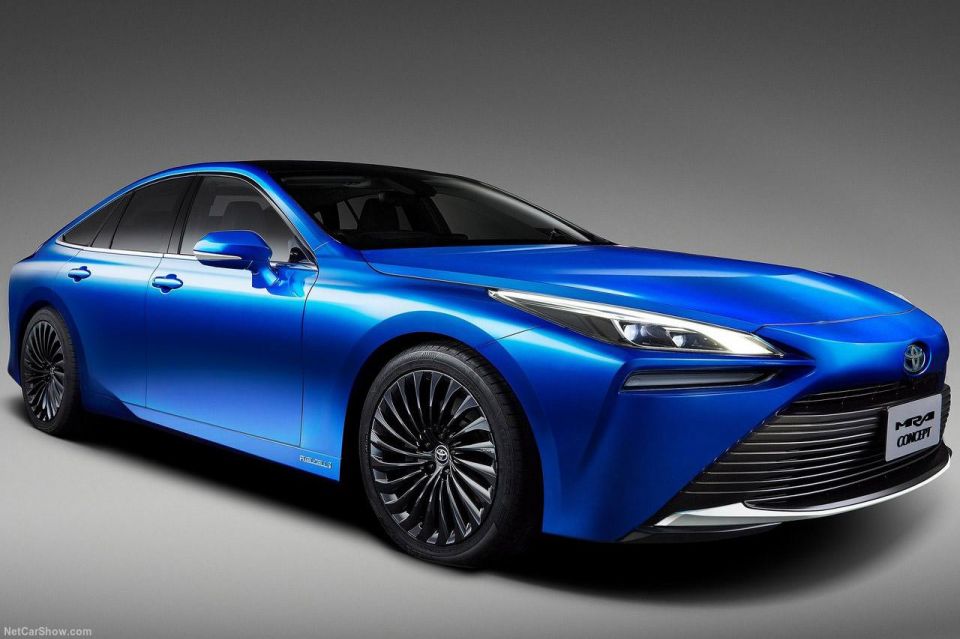
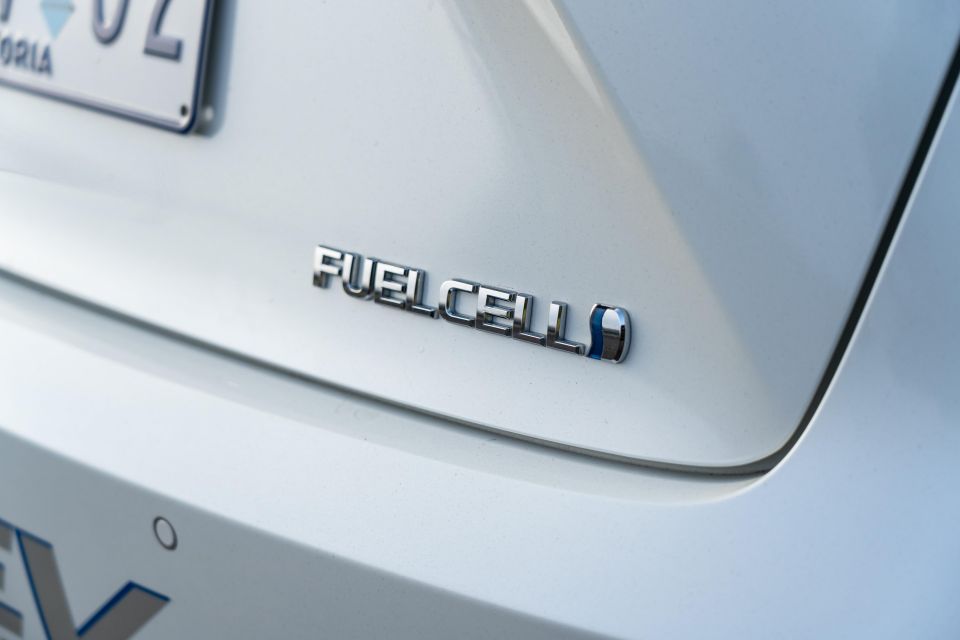
Why is that? Because hydrogen fuel-cell technology is not mature and it’s not ready to be sold. There are some small trials going on, but beyond that, the technology’s just not ready – it’s not reliable, it’s not affordable, and it’s very hard to see how it will play any role at all in the car market.
Maybe hydrogen may play a role in the future in terms of heavy vehicles like trucks. But even then, when you look to different organisations like the US Department of Energy, they are putting a lot of money into hydrogen research – billions of dollars trying to see what is possible – but they’re not expecting a hydrogen semi truck to be feasible and competitive until 2050. So we’re talking about this still being 20 to 30 years away.
I work on the Intergovernmental Panel of Climate Change [IPCC] and we’re doing a lot of work looking at all of these different technologies right across the transport sector. What we know is: we don’t have the luxury of waiting till 2050 to decarbonise our transport fleet. We need to be acting now. We need to be implementing technology today and starting that transition.
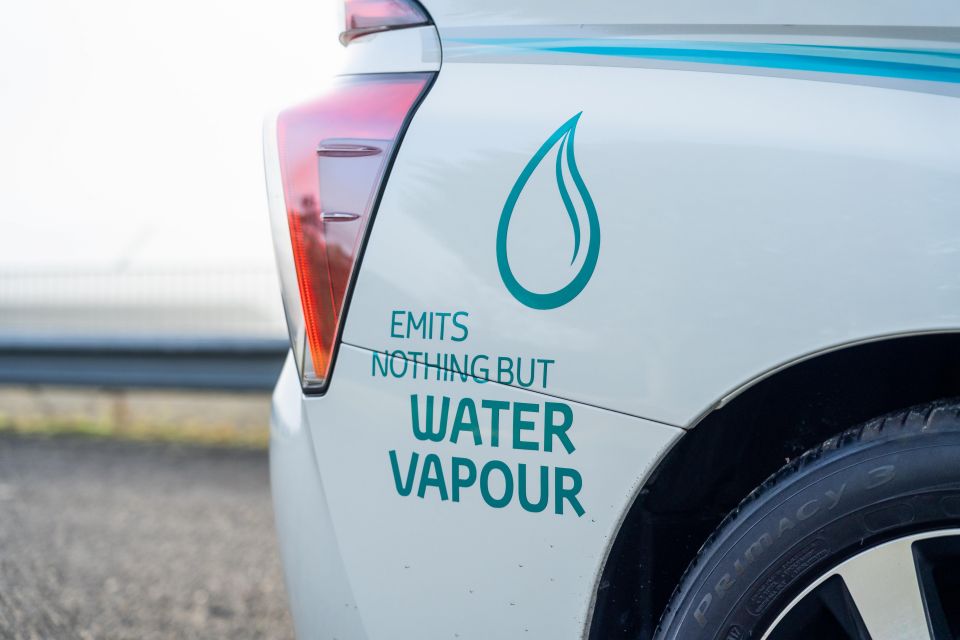
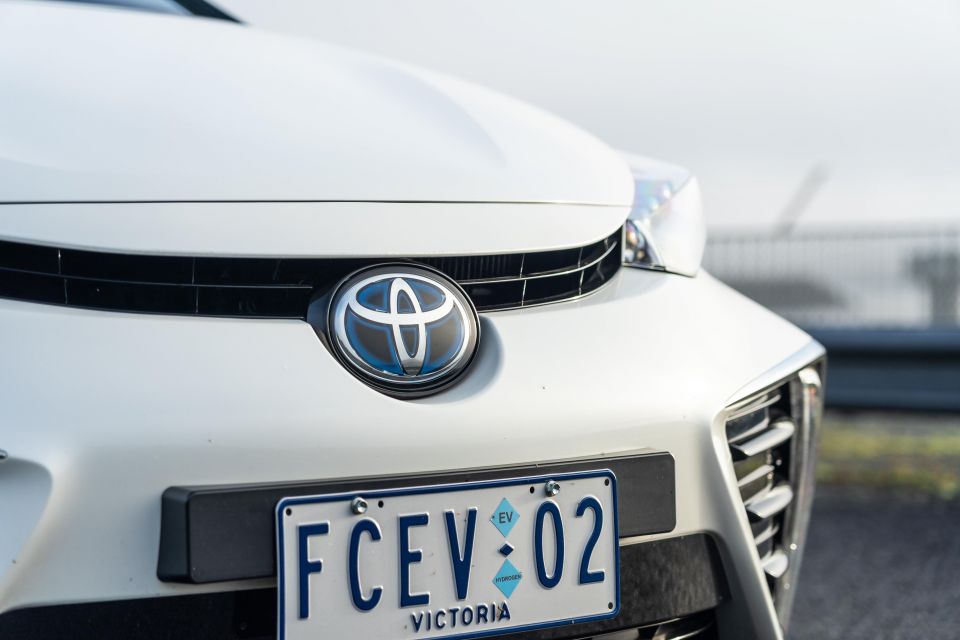
That’s where electric vehicle technology is certainly a viable option for fleets and also for anyone that purchases a vehicle for $50,000 or more – and a lot of people do spend that amount of money on a car.
Wouldn’t we much prefer those market segments to be buying an electric vehicle – as opposed to just doing the same old thing and continuing to fill our streets with fumes?
Look, I think it is interesting to see what’s happening in the hydrogen space – but I also am honestly a bit frustrated that some are using hydrogen as an excuse not to transition to electric today.
That’s my frank response. Other people have different opinions, but you just need to look at the evidence and the vehicles are simply not there.
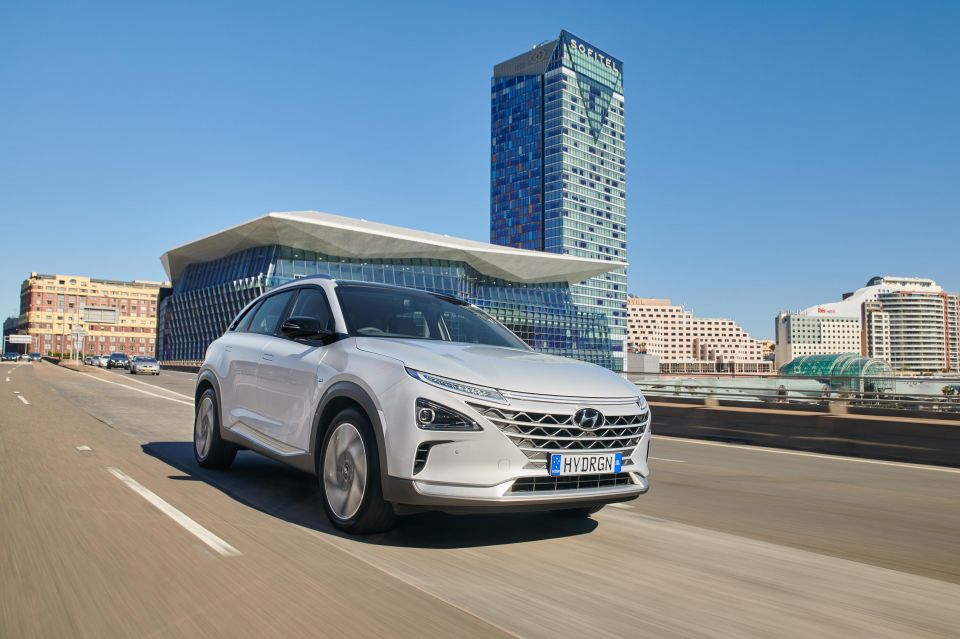
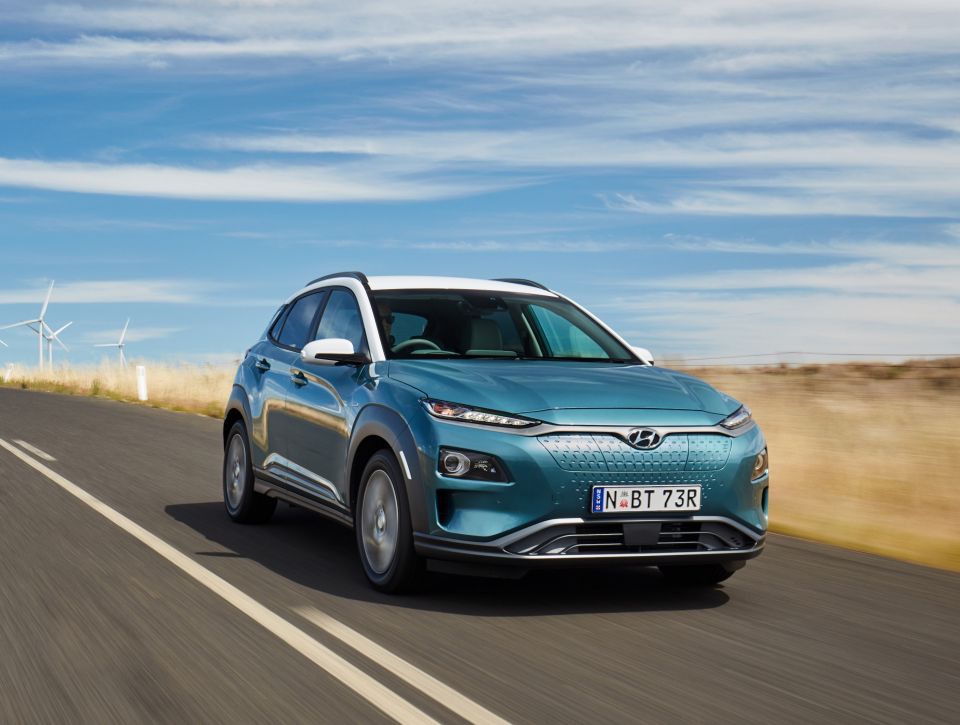
You’ve got the likes of Volkswagen and a whole range of other traditional OEMs saying hydrogen has no role in the light vehicle car market. Really, you’re left with Hyundai and Toyota. And Hyundai; they’re splitting their bets both ways – they’re heavy on electric and they’re also trying hydrogen. But realistically, in the car space, the economics just don’t stack up.
The other point on hydrogen that is overlooked is that if you have a hydrogen car, the amount of energy required to power it will always be two to three times that of an electric vehicle. So, that means we would require two to three times the land space in wind turbines and solar panels, two to three times the amount of renewable energy that you need to produce.
We’re already having challenges meeting a 100 per cent renewable energy target. How are we going to meet a 200 or 300 per cent renewable energy target in the timeline we need to in order to avoid the worst potential consequences of global warming?

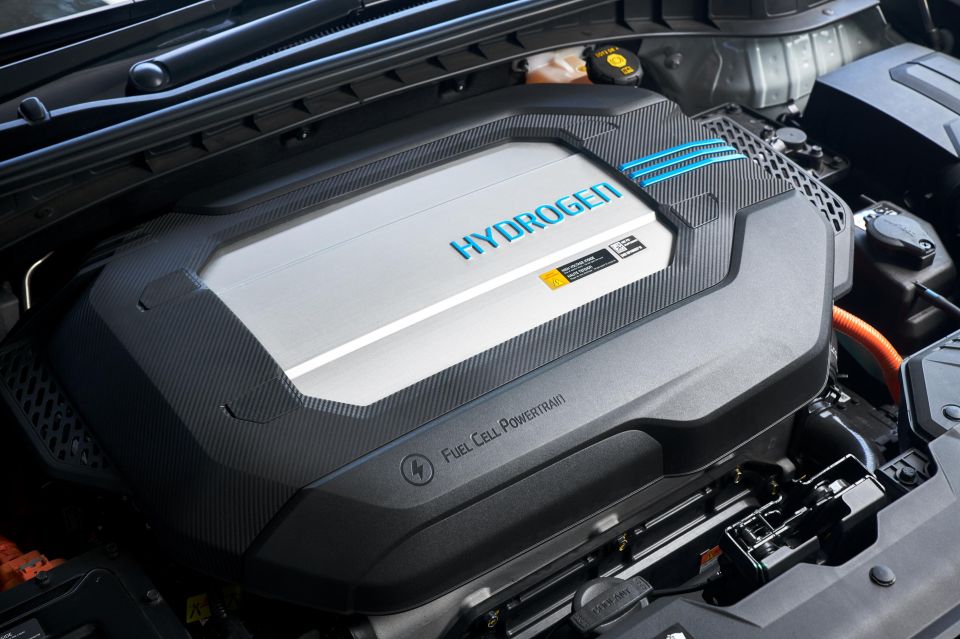
It’s really important that we put this into perspective and that we understand that hydrogen has a role to play. It’s just very unlikely to be in cars and probably also trucks.
Renewable hydrogen has a really important role to play in producing steel, aluminium, cement fertilisers and ammonia. And in the transport sector, instead of cars and trucks, we should be focussed on using renewable hydrogen to produce synthetic renewable fuels for boats and planes.
But for those applications alone, the amount of renewable hydrogen we will need to produce is massive, so we need to be upfront about this, and understand the magnitude of the challenge this presents in the context of needing to achieve net zero emissions by 2050 to restrain global warming well below 2 degrees.
Until we’ve reached the day where we have unlimited renewable energy, we must continue to focus on the most energy efficient technology options. And that’s where we get back to electric vehicles; they are the most energy efficient option for the land transport sector.

JW: We’re really proud that we were able to unveil our Warwick solar farm a couple of weeks ago. That in addition to the rooftop solar that we have at UQ Saint Lucia, as well as our Tesla battery and our Gatton solar farm together produces more renewable energy than we consume. These are our major efforts so far towards trying to reduce the carbon intensity of our electricity consumption.
One thing to note, though, is that if you charge an electric vehicle from the current grid today, you will still reduce carbon emissions by 30 to 40 per cent on average. And importantly coming back to the health issue, you take those emissions out of built-up urban areas where they are currently having a significant impact on the public health of you, me, our parents, our kids, our future grandkids. That in of itself should be enough of a motivating factor.

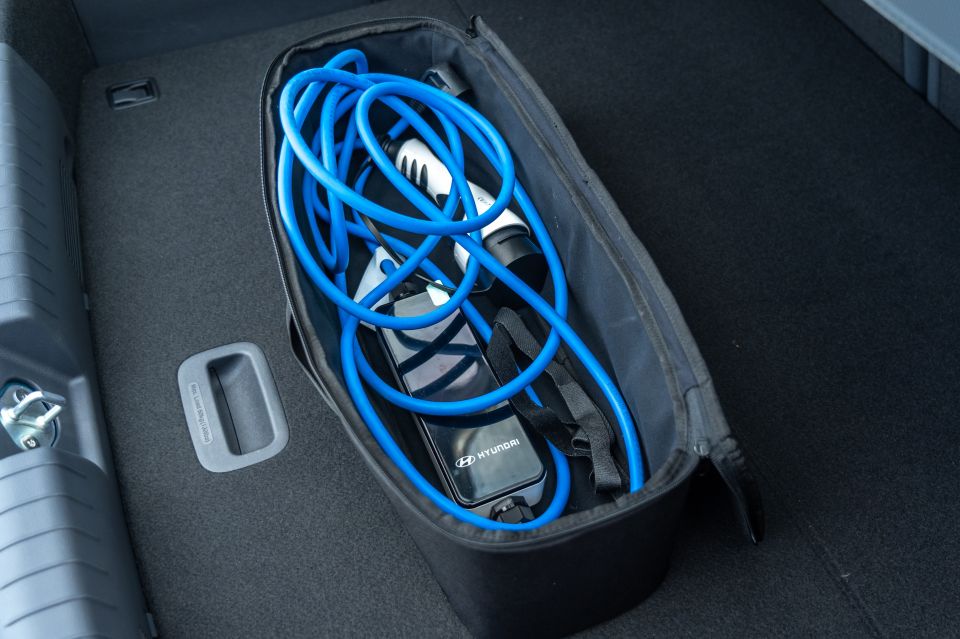
If we come back to battery manufacturing, here in Australia we should be looking at this as a major economic development opportunity. We have lithium. We have copper. We have nickel. We have cobalt.
We have all of these resources that we can mine sustainably, and at the same time, we’re currently faced with the challenge of thinking through: well, how do we transition people that have been working in, for example, the coal industry for many many years? They need jobs to go to and shouldn’t be left behind.
Well, it just happens that we have these other minerals that we need – and that the world needs – and we should be supporting those miners to transition into these energy materials so that we can mine and eventually manufacture batteries sustainably right here in Australia. I’m really looking forward to the day where we can go out and buy an Australian made lithium-ion battery that’s been produced out of Australian minerals. That is what we should be aiming for the future of Australia. We need to have a bit more ambition in this country and achieve this outcome.
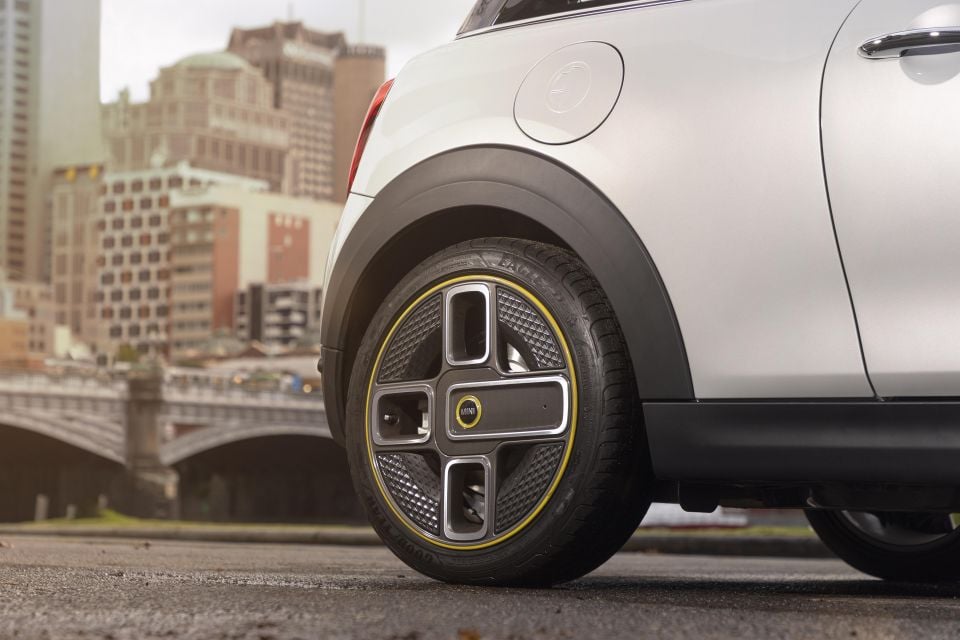

We should all be much more excited about what this opportunity means for Australia’s future. And we need to commit to that future, not only for the sustainability of our global transport and energy systems, but also for our own economic prosperity.
At UQ, we have a Tesla Powerpack which was installed at the Saint Lucia campus late last year. So far, it’s been really successful in terms of the learnings that have come out of the process of installing and managing the battery, as well as the economic dividends that it’s bringing back, in terms of how much revenue it’s been able to generate in a relatively short period of time.
It’s still an ongoing project, and it’s still very much in the early days. But we have a great team at UQ that manages that entire process; [they have] developed effectively a smart algorithm that sits behind and makes all of the decisions about what that battery should do. And it’s learning. It’s constantly learning, taking on board that feedback and improving.
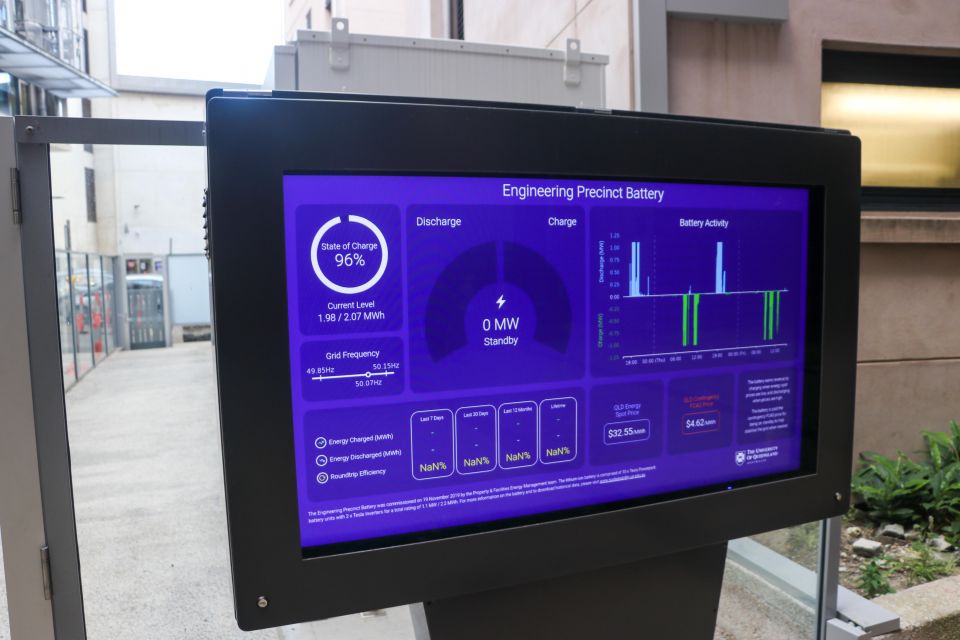
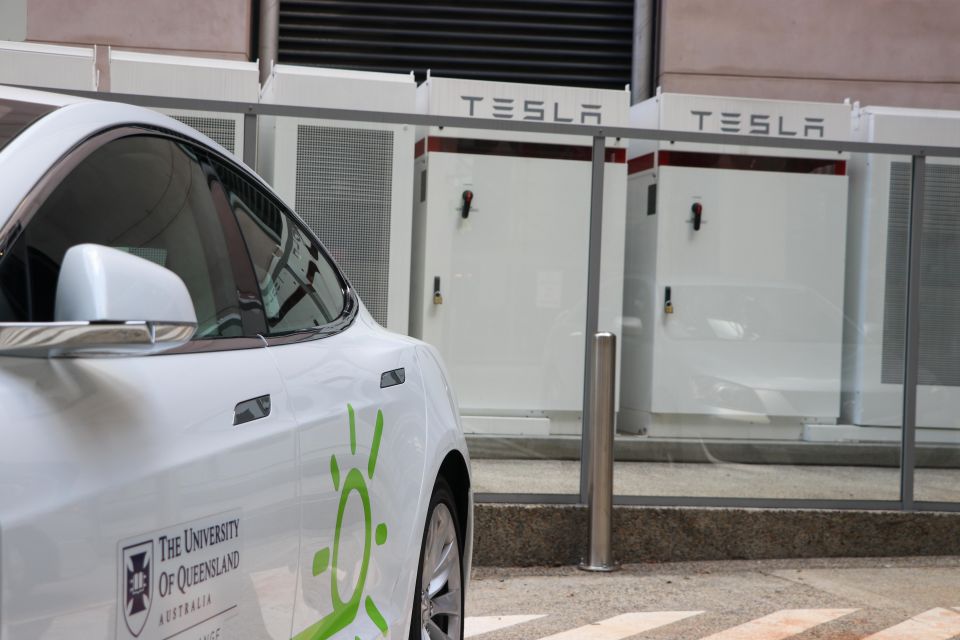
But I think it’s really exciting, that space of batteries and what that means for the grid. So you’ll have a mixture in the future of stationary batteries like that Tesla battery, as well as electric vehicle batteries plugged into the grid. That is where the real exciting use case is.
Because if every single car in Australia – which is about 14 million at the moment – were all electric; and they had a relatively low driving range of let’s say 250 kilometres, together that entire fleet could run the whole country, all of Australia, for 24 hours and still meet the average driving needs of an Australian household.
So, there’s huge capacity to leverage this electric vehicle fleet to provide energy storage. That’s another motivating factor for us to support this transition so we can have a more resilient electricity grid, and also reduce electricity prices. Electric vehicles are going to be an important part of ensuring we have a greener, cheaper, and more reliable electricity future.
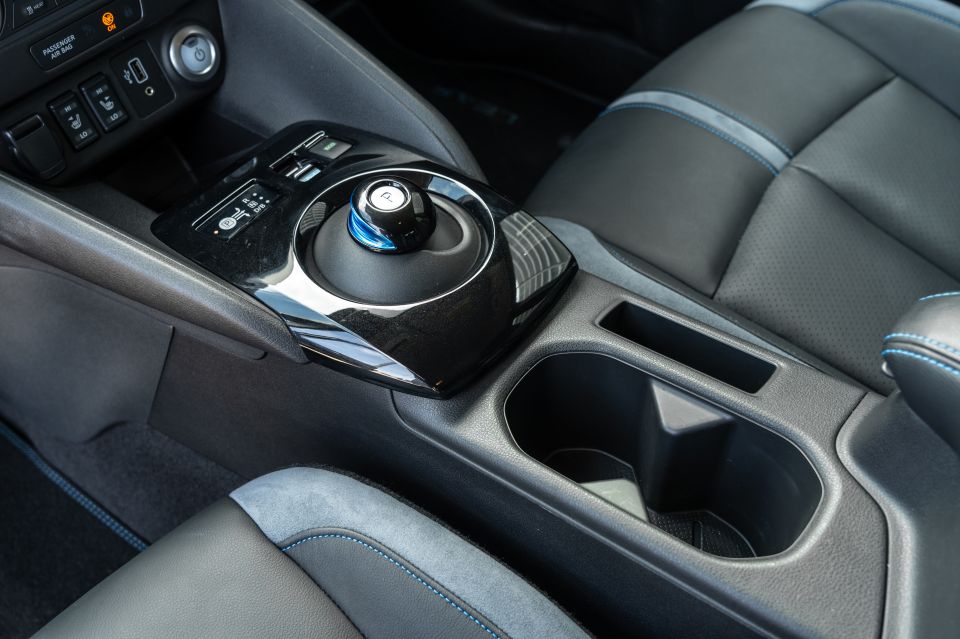
JW: So we’ve had the Tesla for a number of years now, and many staff have taken that opportunity to experience what an electric vehicle is – particularly on trips out to our Gatton campus. Before they go to pick up the vehicle, they’re given some videos to understand how the technology works, and then they’re given a tutorial or demonstration before they take the vehicle out.
Realistically, once you understand how to operate the vehicle in terms of turning it on and parking it, it’s not too different from a traditional vehicle. One of the main things that people take a little while to get used to is the fact that you don’t have an engine to start; you literally put it into drive and it’s on and ready to go.
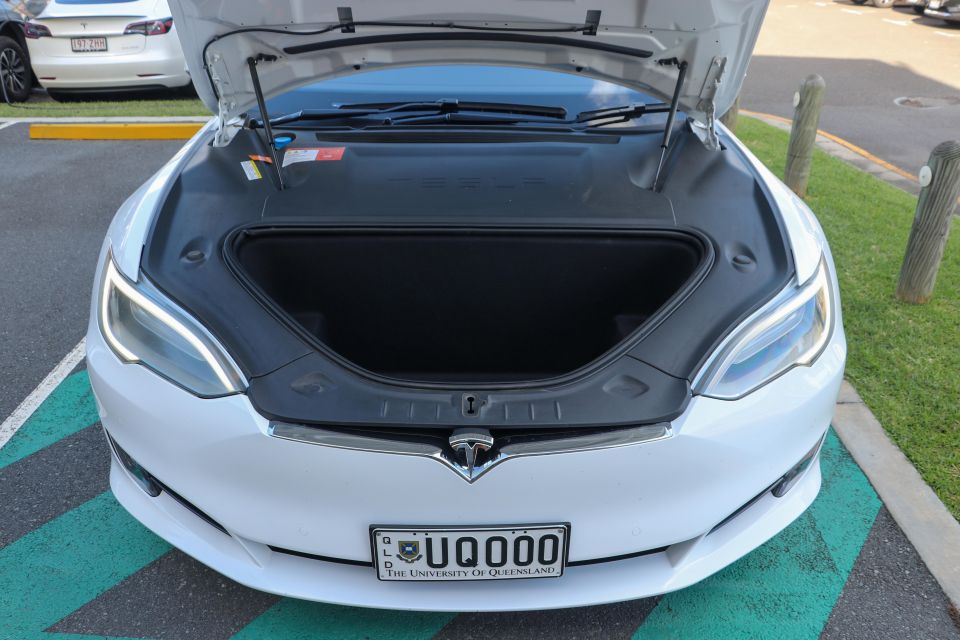
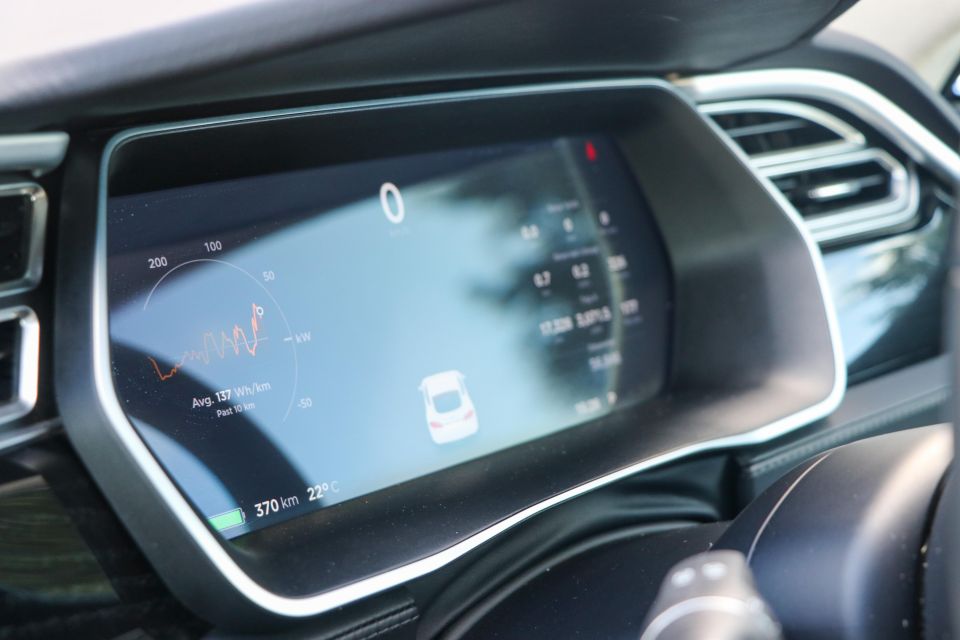
As opposed to an ordinary car, you press a button and it’s off. That does take a little bit of adjustment, but overall the driving experience is very easy. Some people would say it’s similar to an automatic, but there’s actually only a single gear on most electric cars so you don’t even have any gear shifting.
It’s just smooth driving, which is a really nice experience. We’ve been really happy about the opportunity that these vehicles have been able to give to staff as well as students who might be going on a field trip with staff to be able to understand what an electric vehicle means. And for me, I often take these electric vehicles to primary schools, high schools and other public events to give demonstrations and help the wider community understand what the technology means for their future.
So having electric vehicles at UQ is also a really good education tool in that sense as well.

JW: We are currently working on a number of new projects that will start to deliver results in the next 12 months or so. In particular, I am really looking forward to being able to demonstrate what consumers think about electric vehicles in Australia, how much they’re willing to pay, what are the type of features that they’re looking for in the car and also, if they had the opportunity to use a vehicle to grid capabilities, how would that affect their choices and views?
How much would they want to be paid for an electricity company to take energy out of their vehicle, or for them to delay their charging from 9pm at night to 1am in the morning?
So all of those questions are really important to then be able to assess how people are going to use electric vehicles in the future and how we can support a smarter form of charging.
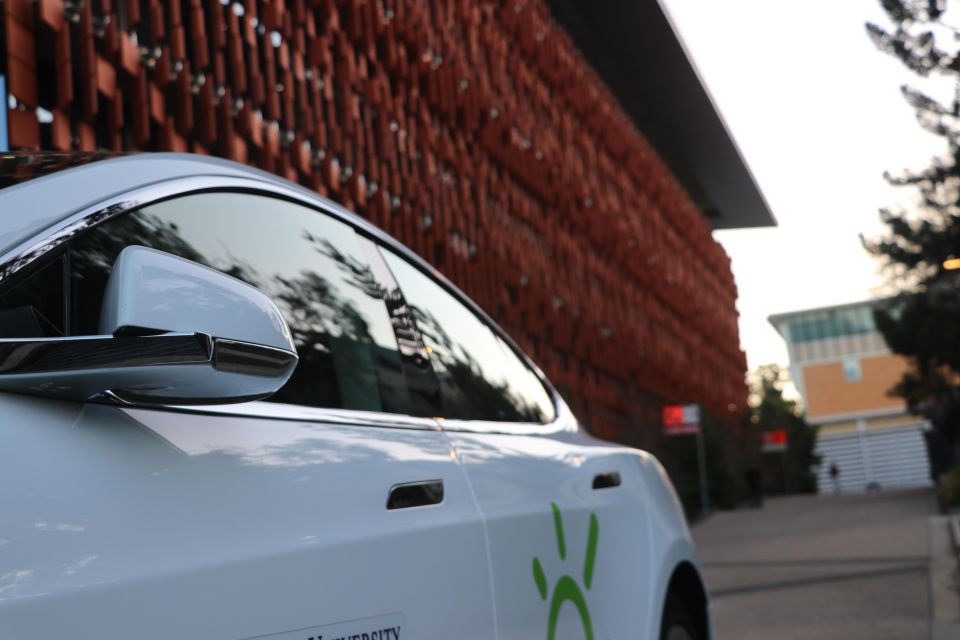
JW: I don’t think it’s unrealistic to expect that in the next decade, we can be aiming for a 100 per cent electric vehicle fleet.
Now, there may be some exceptions; there may be some very specialist vehicles that for different reasons can’t yet be electrified. But by and large, I’m very confident that in the next decade we’re going to see not only a rapid continuing reduction in the price of electric vehicles but also that the adoption rate will start to accelerate.
Again, fleets really need to be leading the charge, literally, and be demonstrating how easy it is to own and operate electric vehicles. I very much hope we can continue to support that more broadly in Australia through UQ’s own efforts.
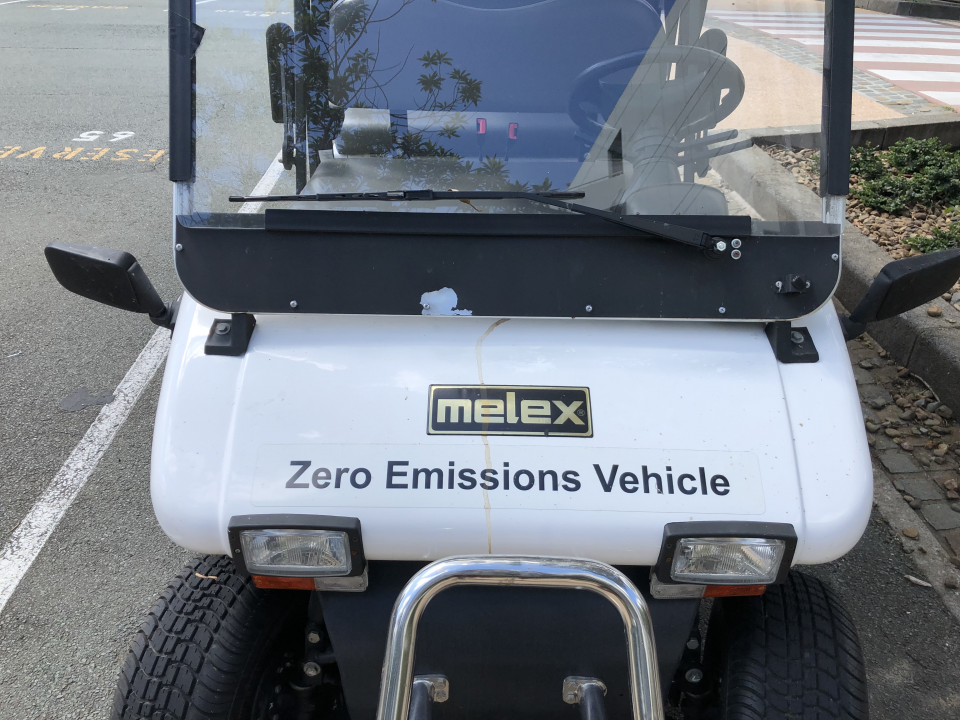
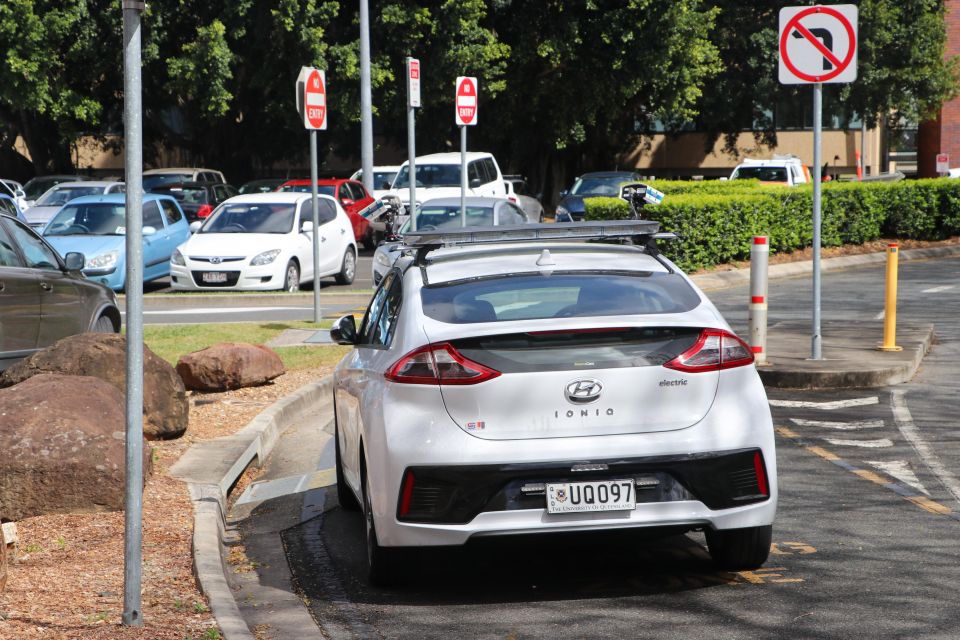
And realistically, more widely, we need to be aiming for 100 per cent electric vehicle sales sometime in the mid-2030s, because we’re already seeing the likes of the UK, Norway, India, China; a whole range of countries around the world that have announced they’re going to be introducing bans on the sale of petrol and diesel vehicles in that time period.
This is real. This is happening. And we need to start preparing for that change.
Coming back to my earlier point, Australia can really benefit from this transition if we’re smart in our economic development policies and looking at how we can leverage these valuable natural resources in Australia to produce batteries to support electric vehicles, as well as a whole range of other exciting uses of lithium-ion technology.

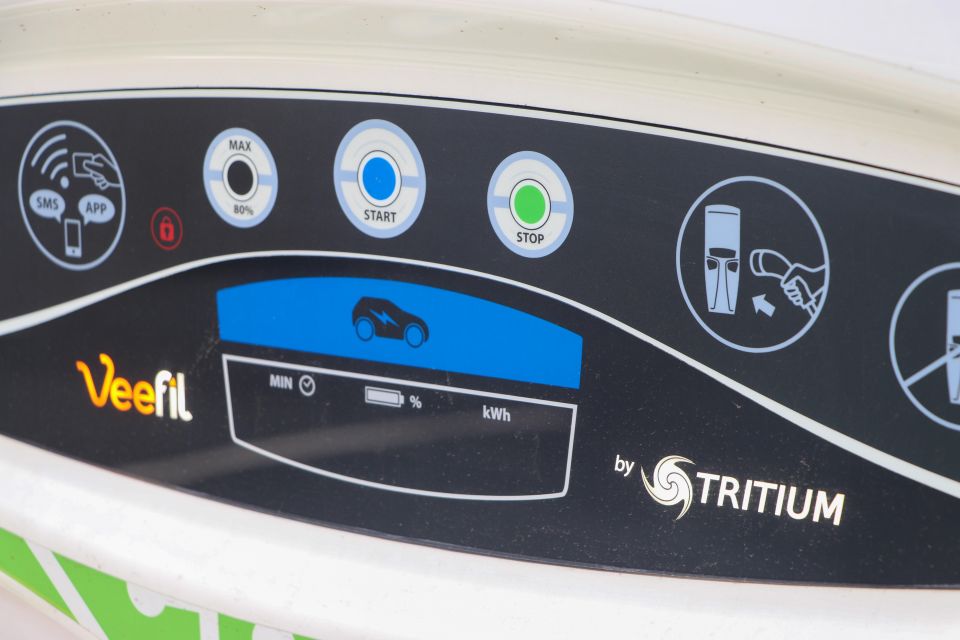
This is in addition to the awesome local companies like Tritium that already are leading the world today with their charging infrastructure technology.
There’s some really exciting news ahead for Australia. We’ve just got to wake up and get on with it.
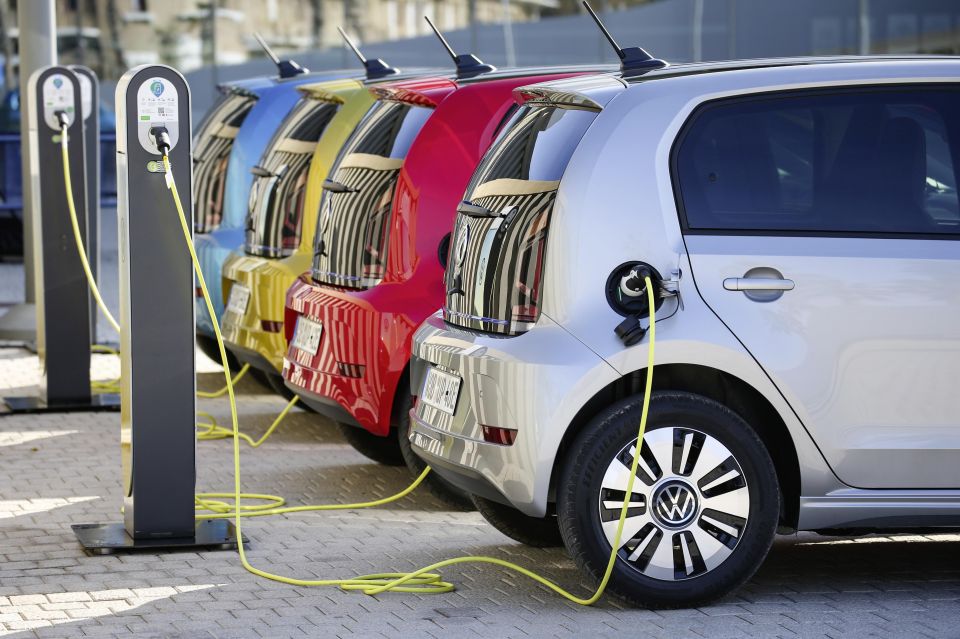
JW: Obviously at the moment, we’re not able to travel as much as we have in the past. But when things start to resume, I’d really encourage people when they go on their next holiday to enquire about whether they can hire an electric vehicle.
You might not be ready to buy one today but when you’re going away somewhere, whether it’s in Australia or overseas, it’s a really great opportunity to be able to experience an electric vehicle and understand how it works.
And also, don’t be afraid to call dealers and ask them for a test drive. You know, most electric vehicle companies are more than happy to give people the opportunity to experience an electric vehicle.
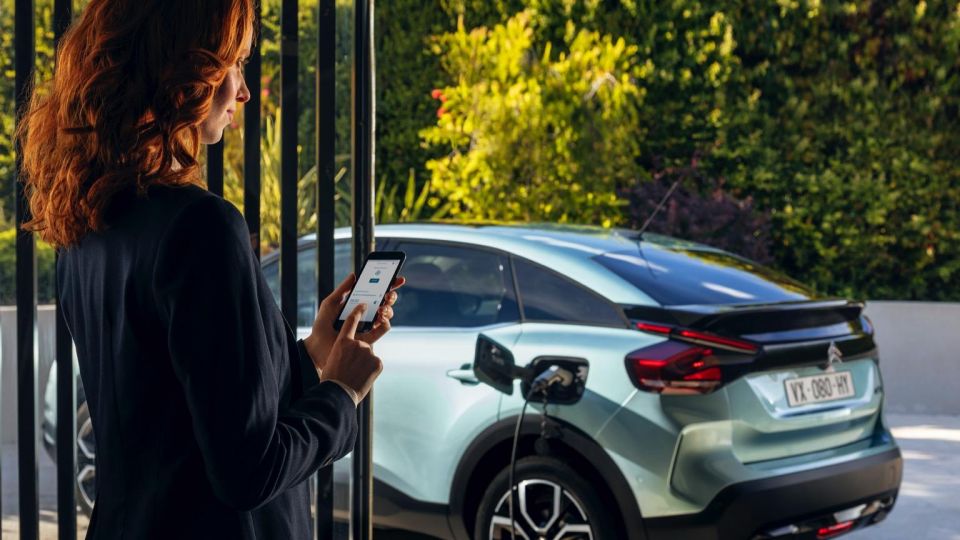
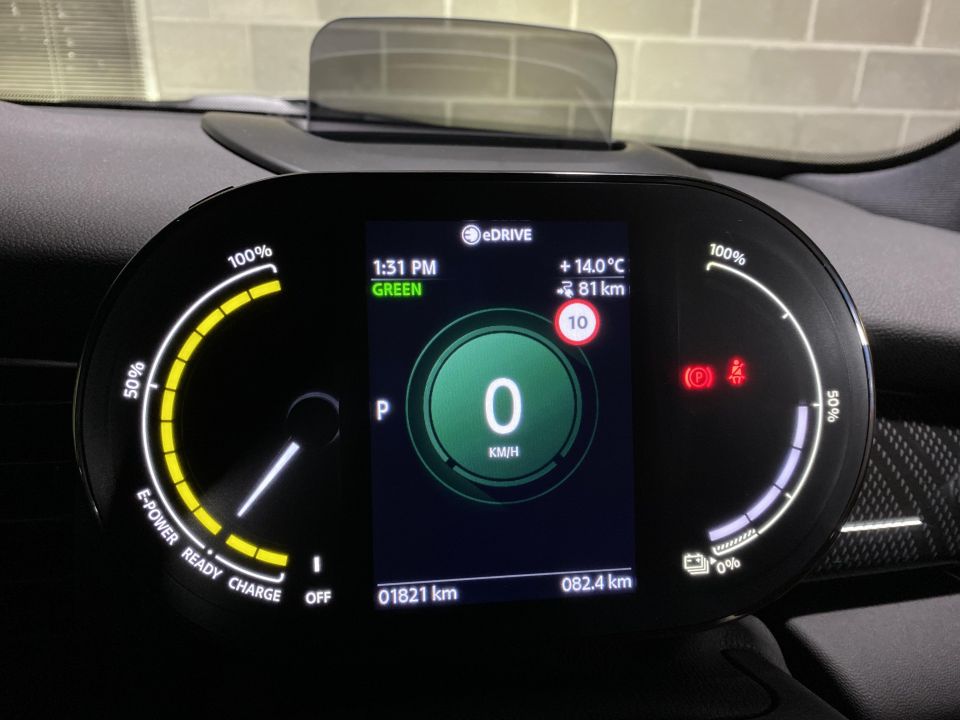
Don’t be shy, take that chance to be able to understand what it can mean for you. Even if it’s not something on the immediate horizon for your household, do understand that this is where the market is heading in the next 10 years.
The car market is changing rapidly, and in the coming years there will continue to be more and more affordable models on the market. Hopefully with more fleets like UQ choosing to adopt EVs today, there’ll be more second-hand electric vehicles on the market in the near future, too.
EDITOR’S NOTE: The author is a student at The University of Queensland.


William Stopford
13 Hours Ago


Max Davies
14 Hours Ago


Derek Fung
15 Hours Ago


Matt Campbell
21 Hours Ago


Ben Zachariah
2 Days Ago


Damion Smy
2 Days Ago